Let me structure this according to the requirements with proper word counts and formatting.Container gardens offer endless possibilities for transforming any space into a vibrant growing area, regardless of size limitations. Whether you have a sprawling patio or a tiny balcony, these versatile gardening solutions bring life and beauty to urban environments, rental properties, and traditional homes alike. From herb-filled kitchen gardens to stunning seasonal displays, container gardening allows you to experiment with different plants, colors, and styles while maintaining complete control over soil quality and growing conditions.
1. Vertical Herb Container Garden
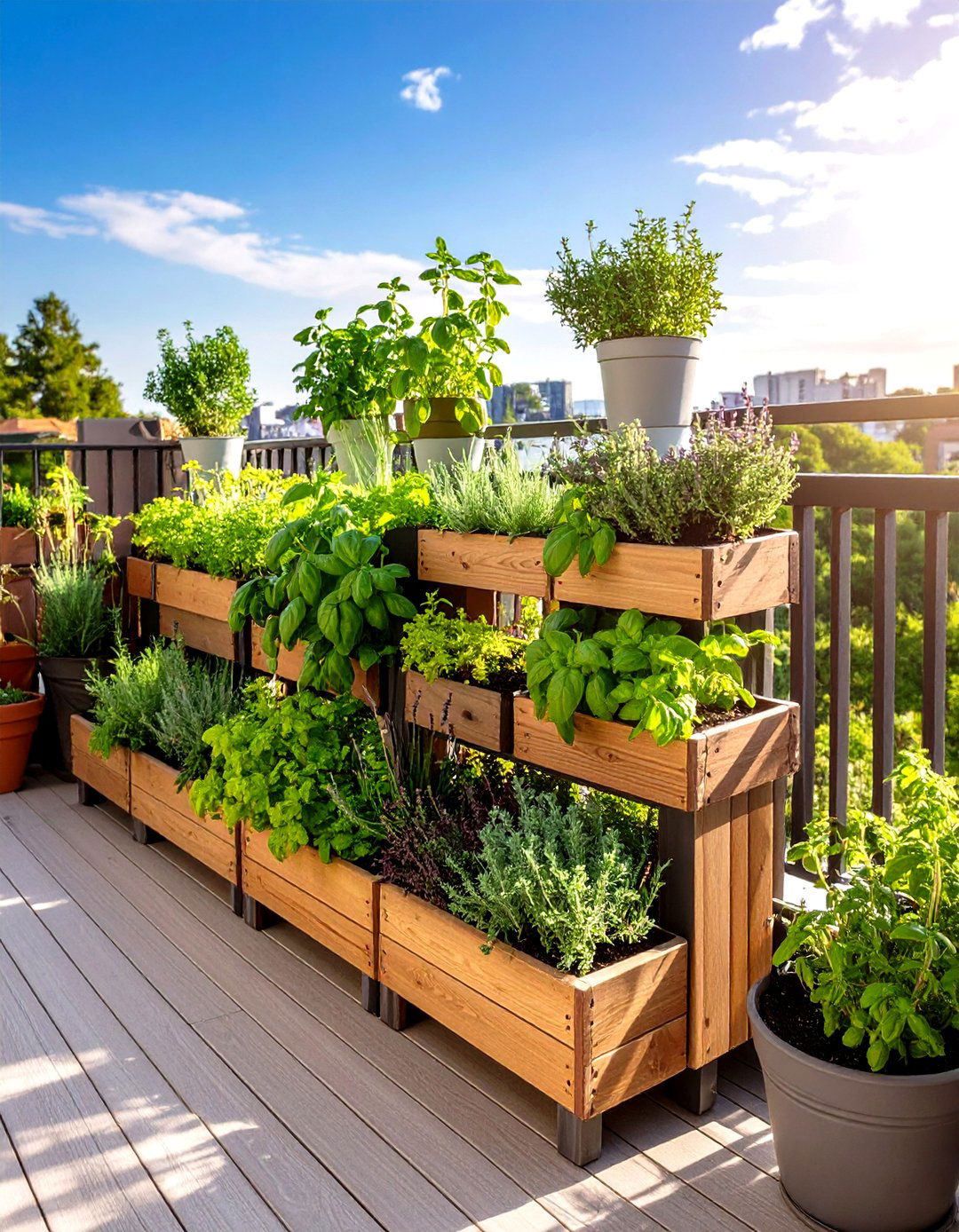
Transform limited space into a productive growing area with stacked planters featuring culinary favorites like basil, thyme, rosemary, and oregano. This space-saving container garden design utilizes tiered arrangements or wall-mounted systems to maximize growing potential in minimal square footage. Choose containers with excellent drainage and position them where they receive at least six hours of sunlight daily. Mediterranean herbs particularly thrive in this setup, as their shallow root systems adapt well to container restrictions. Regular harvesting encourages continuous growth while providing fresh ingredients for cooking. Consider grouping herbs with similar water requirements together, keeping moisture-loving varieties like mint separate from drought-tolerant options like lavender.
2. Succulent Fairy Container Garden
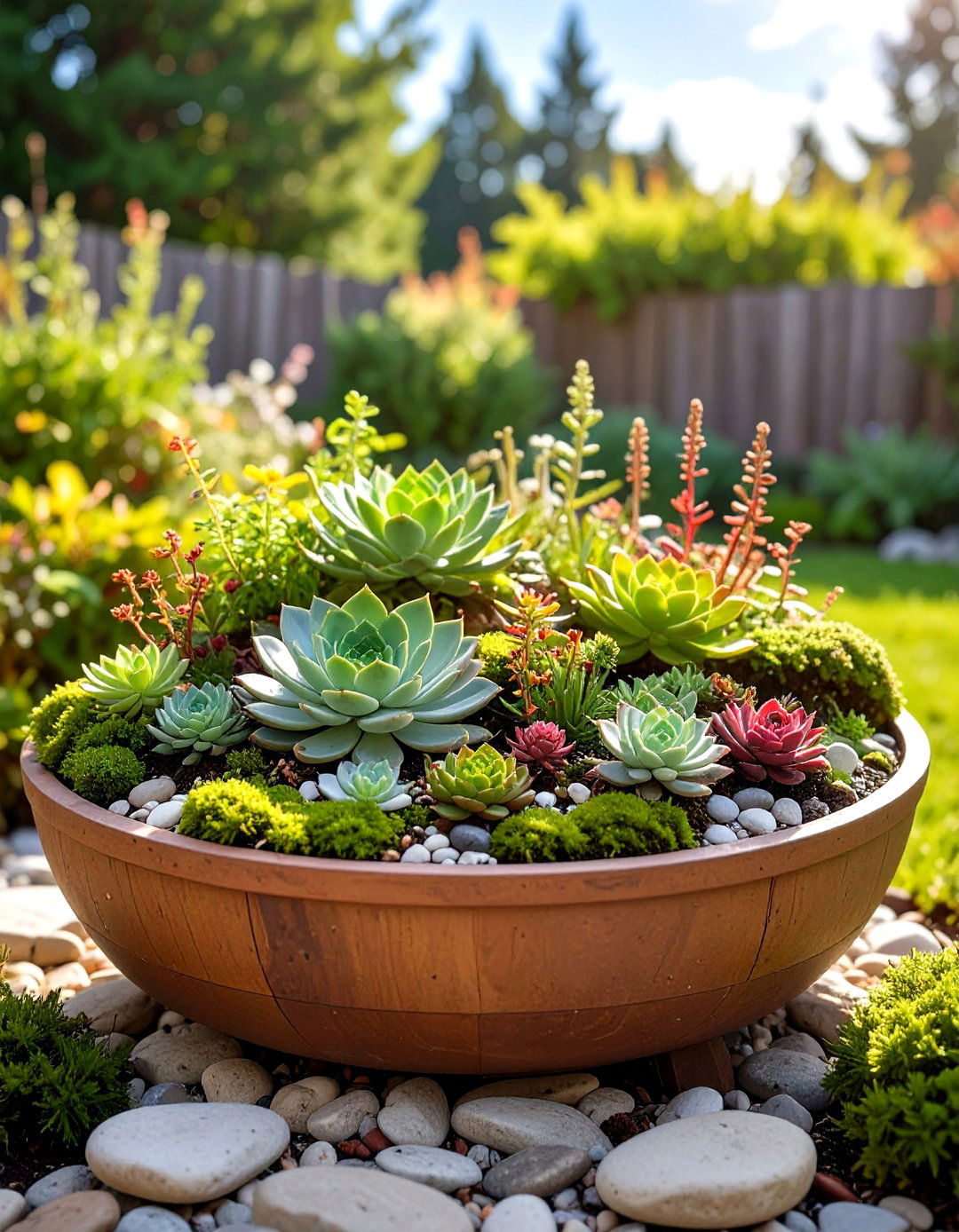
Create magical miniature worlds using drought-resistant succulents combined with tiny figurines, miniature furniture, and decorative elements in shallow containers. This enchanting container garden appeals to both children and adults while requiring minimal maintenance. Select small succulent varieties like echeveria, sedum, and hen-and-chicks that maintain compact proportions over time. Use pebbles, small stones, and moss to create pathways and landscape features around fairy accessories. Position these container gardens in bright, indirect light where morning sun provides optimal growing conditions. The key to success lies in proper drainage and infrequent watering, allowing soil to dry completely between sessions. This whimsical approach transforms basic planters into storytelling landscapes.
3. Seasonal Color-Changing Container Garden
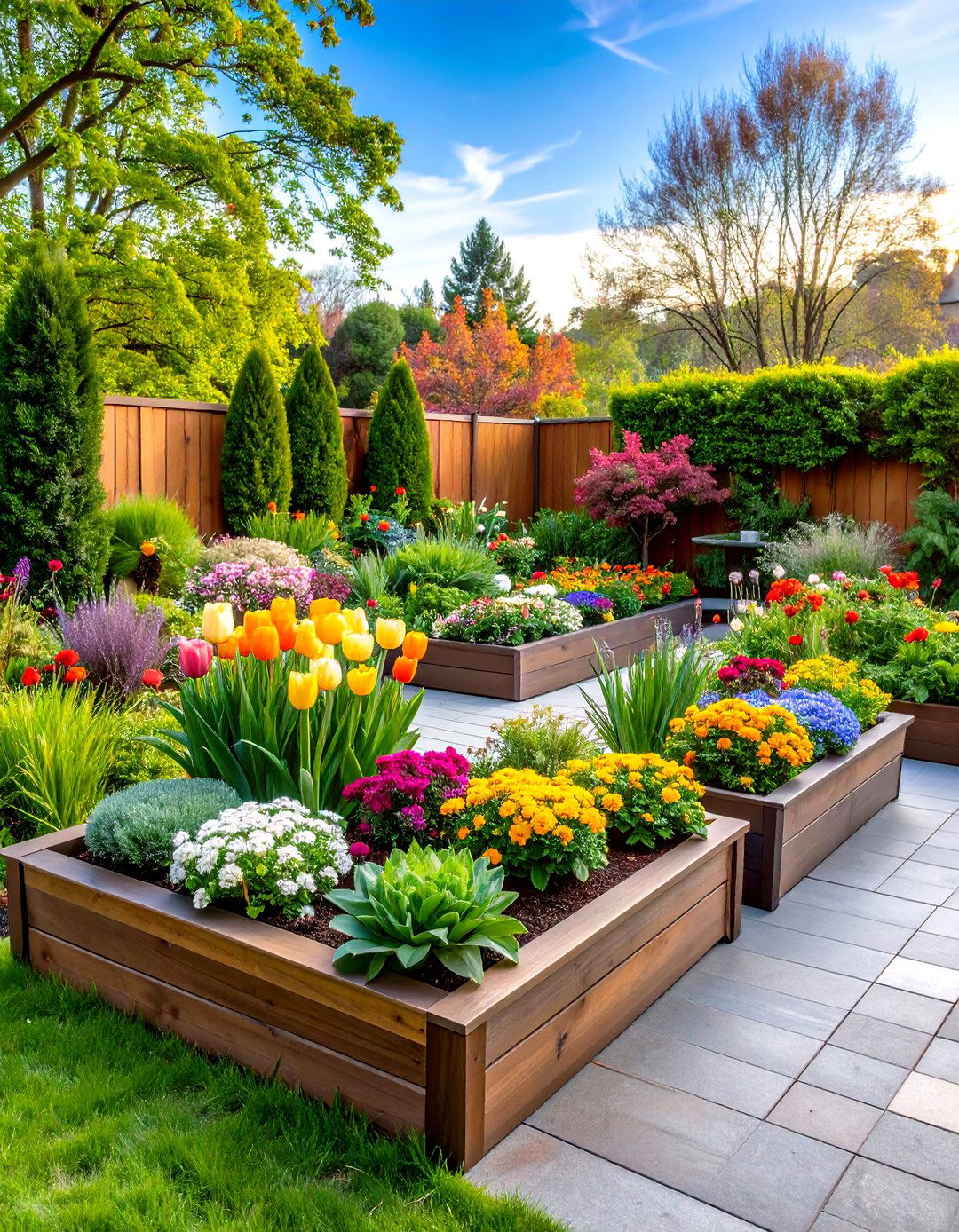
Design dynamic displays that evolve throughout the year by combining permanent structural plants with seasonal flowering annuals for continuous visual interest. This adaptable container garden strategy uses evergreen shrubs or ornamental grasses as foundation elements while rotating colorful additions quarterly. Spring brings tulips and pansies, summer features petunias and marigolds, fall showcases mums and ornamental cabbage, while winter highlights berry-producing plants and architectural foliage. Choose containers large enough to accommodate root growth and seasonal additions without overcrowding. This approach maximizes investment in quality permanent plants while allowing creative seasonal expression. Plan ahead by purchasing seasonal plants in advance and preparing planting schedules that coordinate with local growing seasons for seamless transitions.
4. Edible Vegetable Container Garden
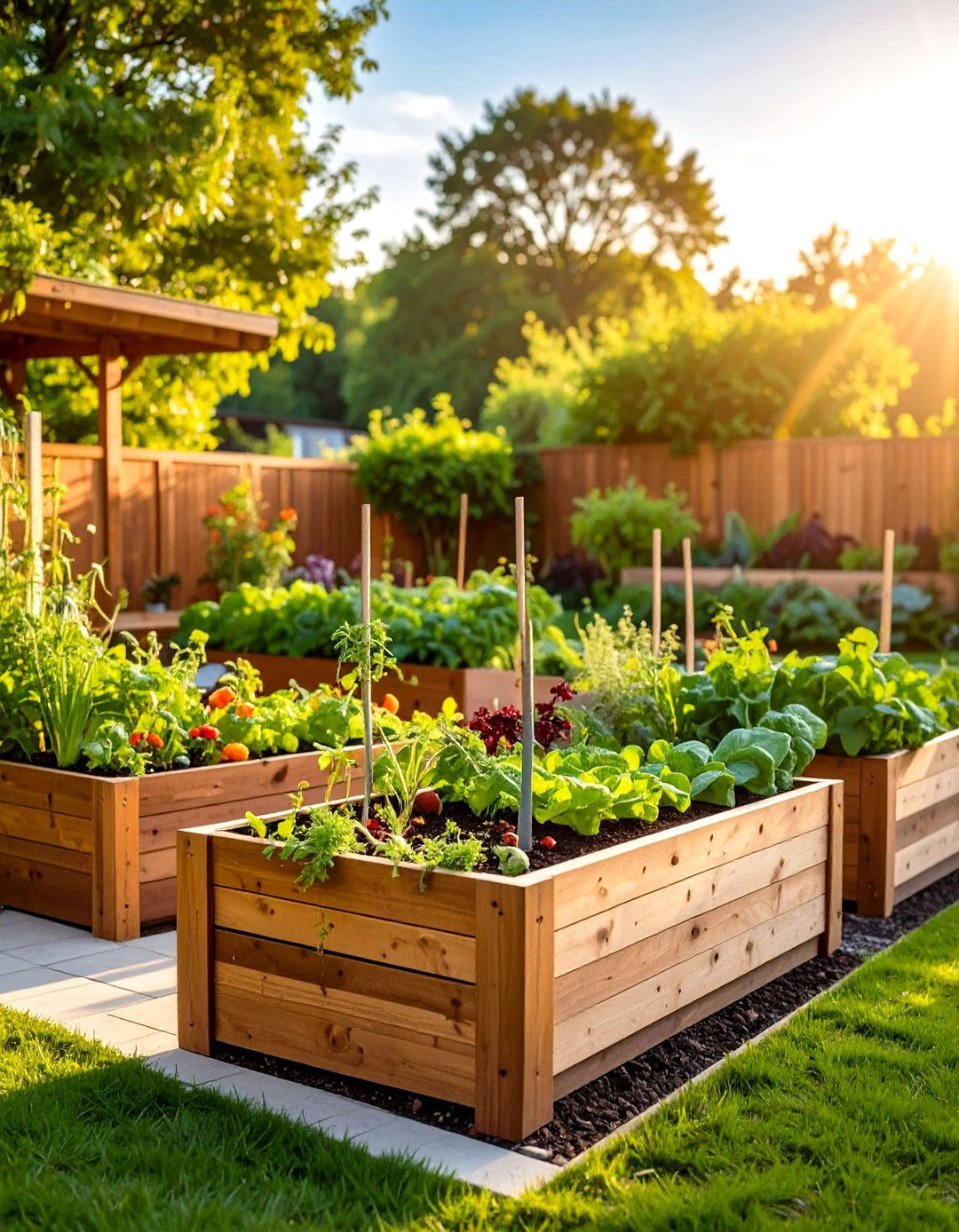
Maximize harvest potential in compact spaces using large containers designed specifically for productive vegetable growing, featuring determinate tomatoes, peppers, lettuce, and compact root vegetables. This practical container garden approach requires containers at least 20 gallons for larger plants like tomatoes and peppers, while leafy greens thrive in smaller 5-gallon options. Focus on high-yield varieties bred specifically for container production, ensuring consistent harvests throughout growing seasons. Implement proper staking systems for vining crops and practice succession planting for continuous lettuce and radish production. Regular feeding with balanced organic fertilizers supports heavy-producing plants, while companion planting with herbs naturally deters pests. Position containers where they receive full sun exposure for optimal fruit and vegetable development.
5. Native Plant Container Garden
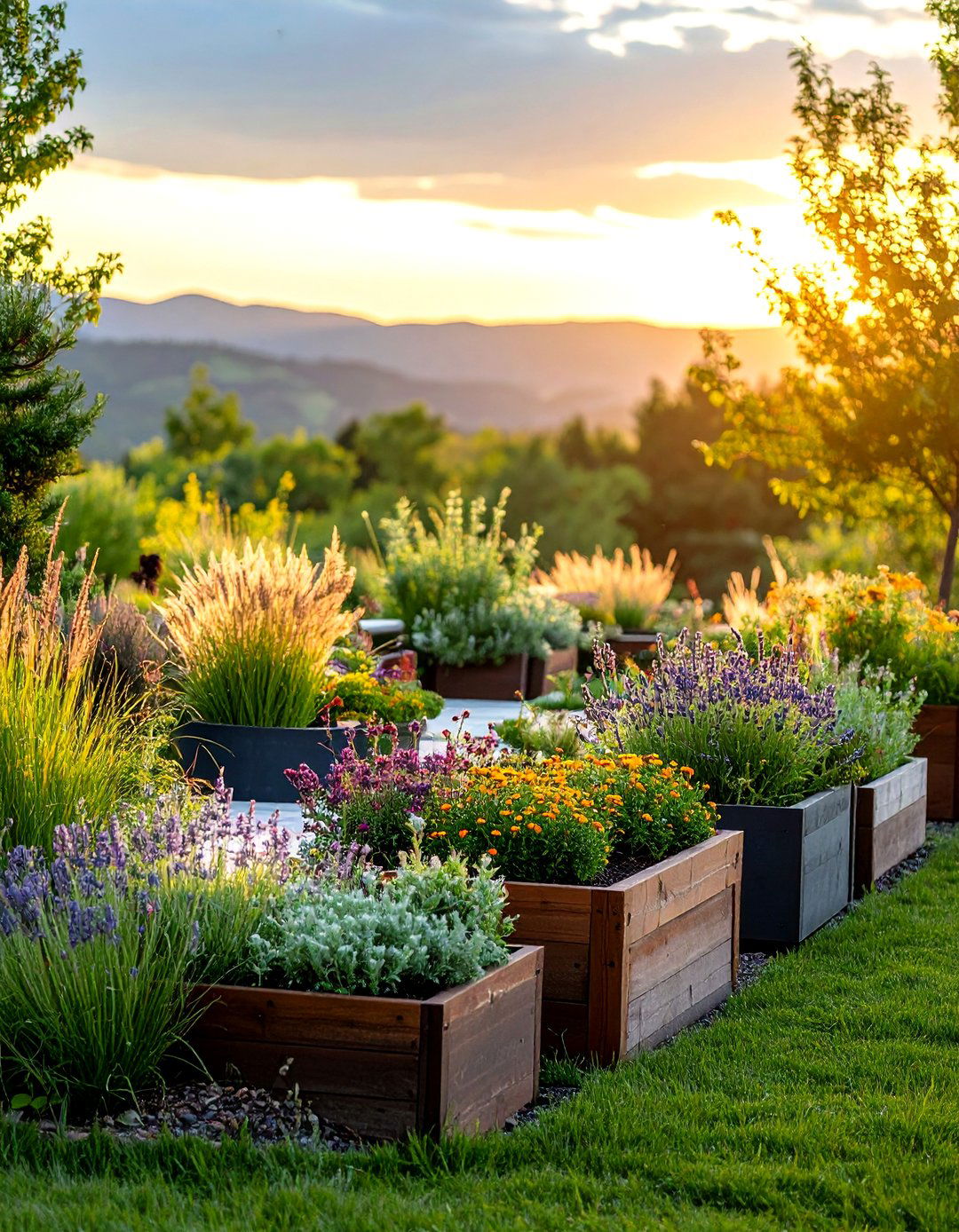
Support local ecosystems while creating low-maintenance displays using indigenous plants adapted to regional climate conditions and wildlife needs. This eco-friendly container garden approach reduces water consumption while providing essential habitat for native pollinators, birds, and beneficial insects. Research plants native to your specific region, selecting varieties with different bloom times to ensure season-long pollinator support. Native grasses, wildflowers, and shrubs typically require less fertilization and pest management than non-native alternatives. These container gardens serve dual purposes by beautifying spaces while contributing to biodiversity conservation efforts. Consider grouping containers with different native plant communities to represent various local habitats like prairie, woodland, or wetland environments. Partner with local native plant societies for expert guidance on appropriate species selection.
6. Window Box Container Garden
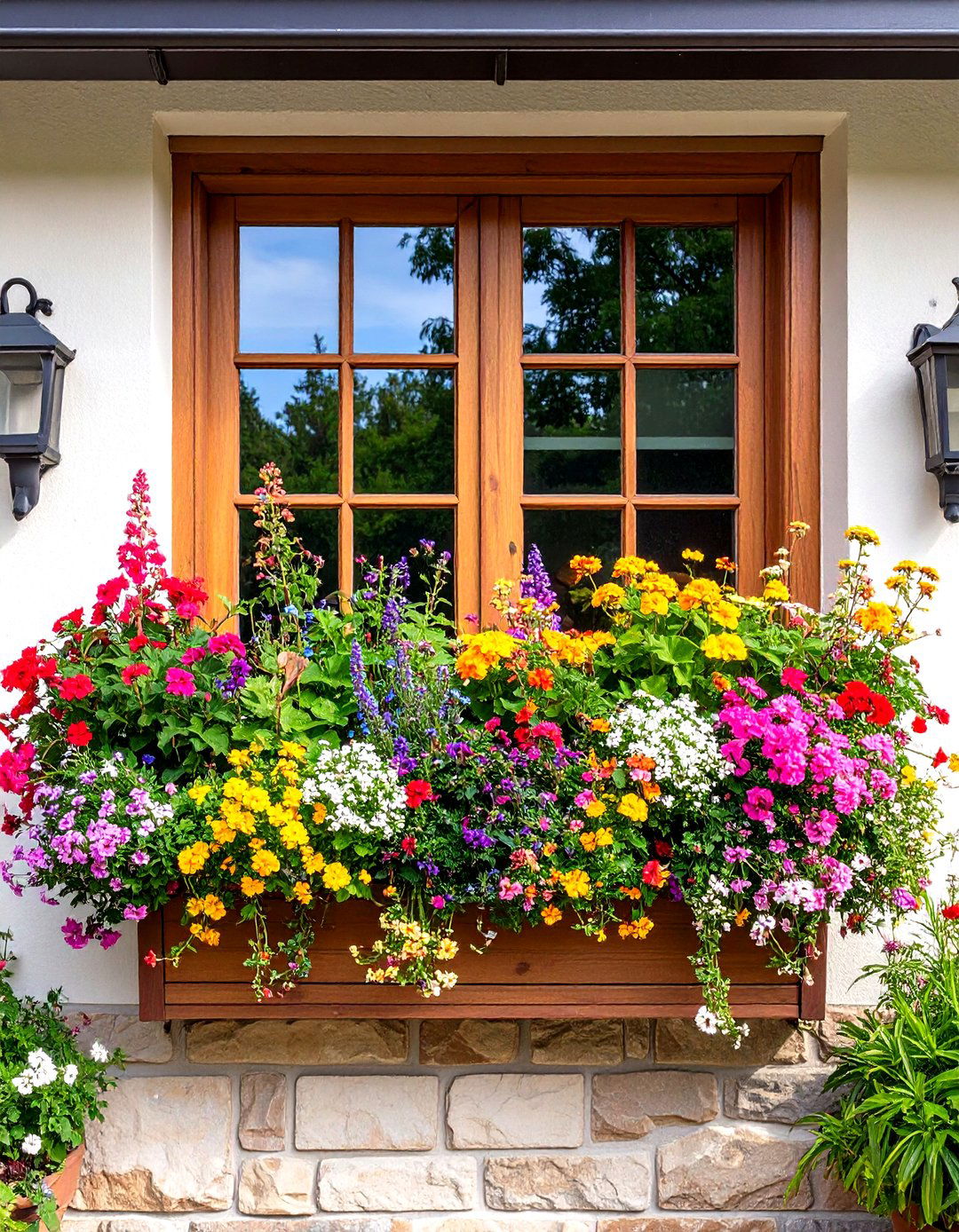
Enhance curb appeal and bring growing space directly outside living areas using elongated planters mounted beneath windows or along railings. This traditional container garden style works particularly well for herbs and flowering annuals that benefit from easy access and regular attention. Ensure proper mounting hardware supports the weight of soil and plants when fully saturated with water, considering seasonal wind exposure in installation planning. Select trailing varieties like ivy geraniums and bacopa to soften hard edges while upright plants like snapdragons provide vertical interest. This container garden type requires consistent watering due to increased wind exposure and limited soil volume. Position plants according to sun exposure, with shade-tolerant varieties for north-facing windows and sun-lovers for southern exposures.
7. Hanging Basket Container Garden
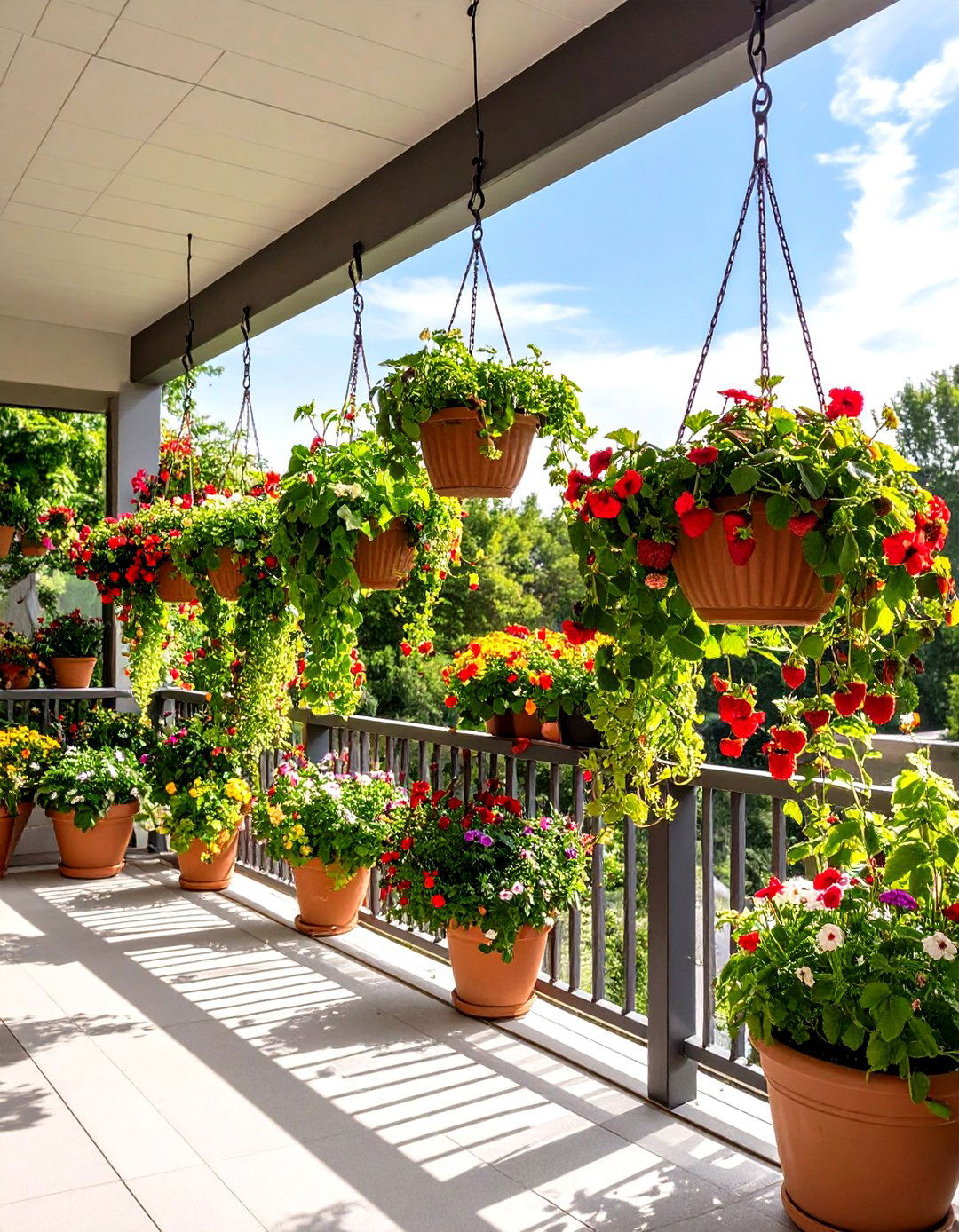
Create stunning aerial displays using suspended planters filled with cascading plants that add vertical dimension to outdoor spaces. This container garden technique maximizes growing space without consuming valuable floor area, making it ideal for small patios and balconies. Choose plants with naturally trailing habits like petunias, fuchsias, strawberries, and trailing tomatoes for best visual impact. Install sturdy mounting systems capable of supporting wet soil weight, considering seasonal plant growth in calculations. These container gardens require more frequent watering due to increased air circulation and drainage, potentially needing daily attention during hot weather. Select self-watering hanging systems or install drip irrigation for vacation maintenance. Position baskets where trailing growth won't obstruct walkways or create maintenance challenges while ensuring adequate sunlight exposure for chosen plants.
8. Water Feature Container Garden
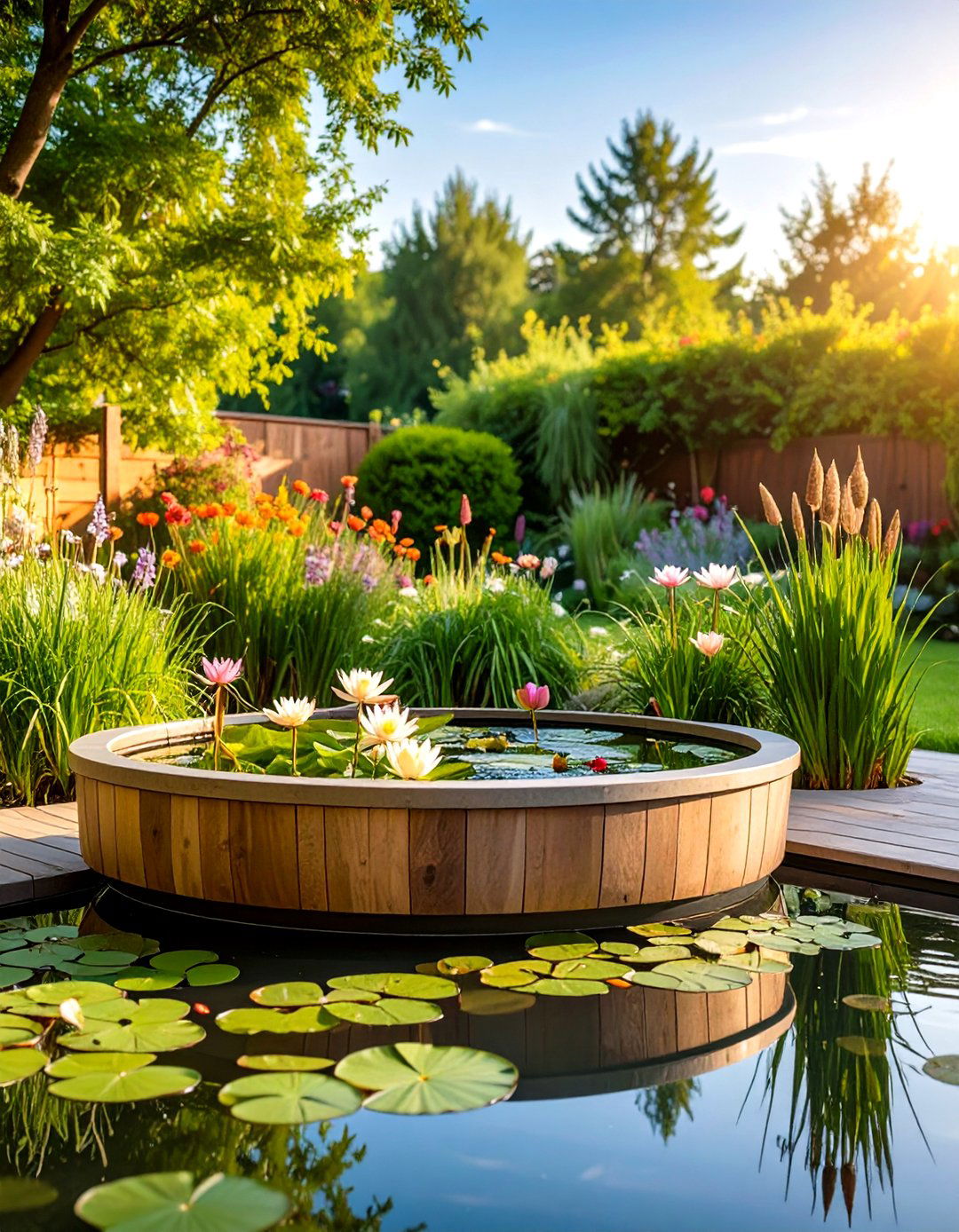
Combine aquatic plants with small water elements to create soothing focal points featuring water lilies, lotus, cattails, and ornamental grasses in large waterproof containers. This unique container garden approach adds tranquil sounds and movement while supporting aquatic plant varieties unavailable in traditional soil-based gardens. Use sealed ceramic pots or dedicated water garden containers with depths appropriate for chosen plants, typically 12-18 inches for most aquatic varieties. Include small pumps for water circulation and oxygenation while adding goldfish for mosquito control and visual interest. Position these container gardens where they receive 4-6 hours of direct sunlight while avoiding excessive heat buildup in smaller volumes. Consider seasonal maintenance requirements including winter protection in freezing climates and regular water level monitoring during hot weather.
9. Tropical Foliage Container Garden
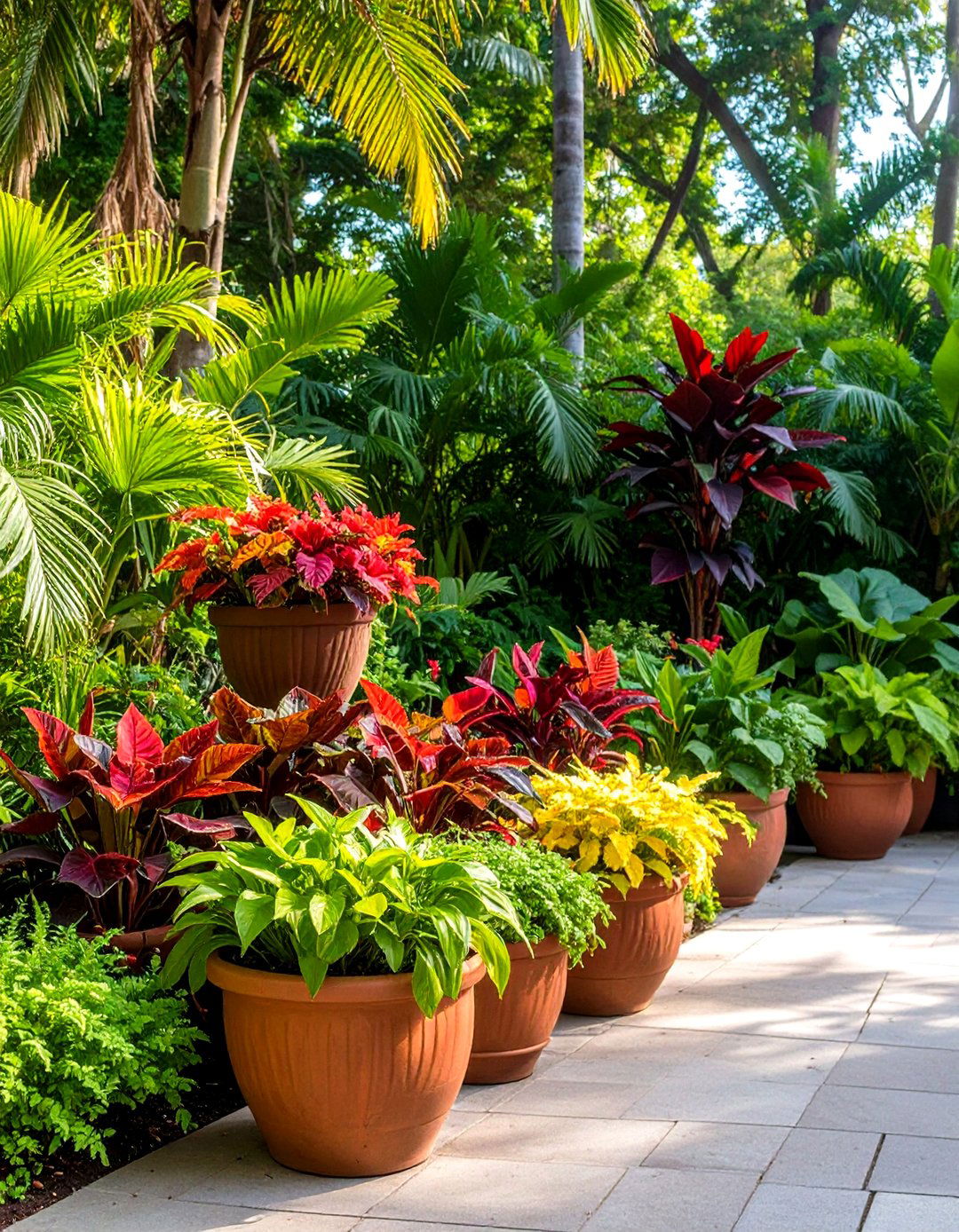
Design exotic displays featuring bold-leafed plants like elephant ears, coleus, caladiums, and begonias that create dramatic visual impact through foliage rather than flowers. This container garden style emphasizes texture, color, and architectural plant forms to achieve sophisticated landscape effects. Select containers large enough to accommodate rapid growth while choosing plant combinations that thrive in similar humidity and light conditions. These dramatic displays work exceptionally well as seasonal focal points on patios or as houseplant collections during colder months. Many tropical plants can be overwintered indoors, extending investment value beyond single growing seasons. Provide consistent moisture and humidity while protecting plants from cold drafts and temperature fluctuations. Consider grouping multiple containers to create microclimate effects that benefit humidity-loving varieties.
10. Zen Meditation Container Garden
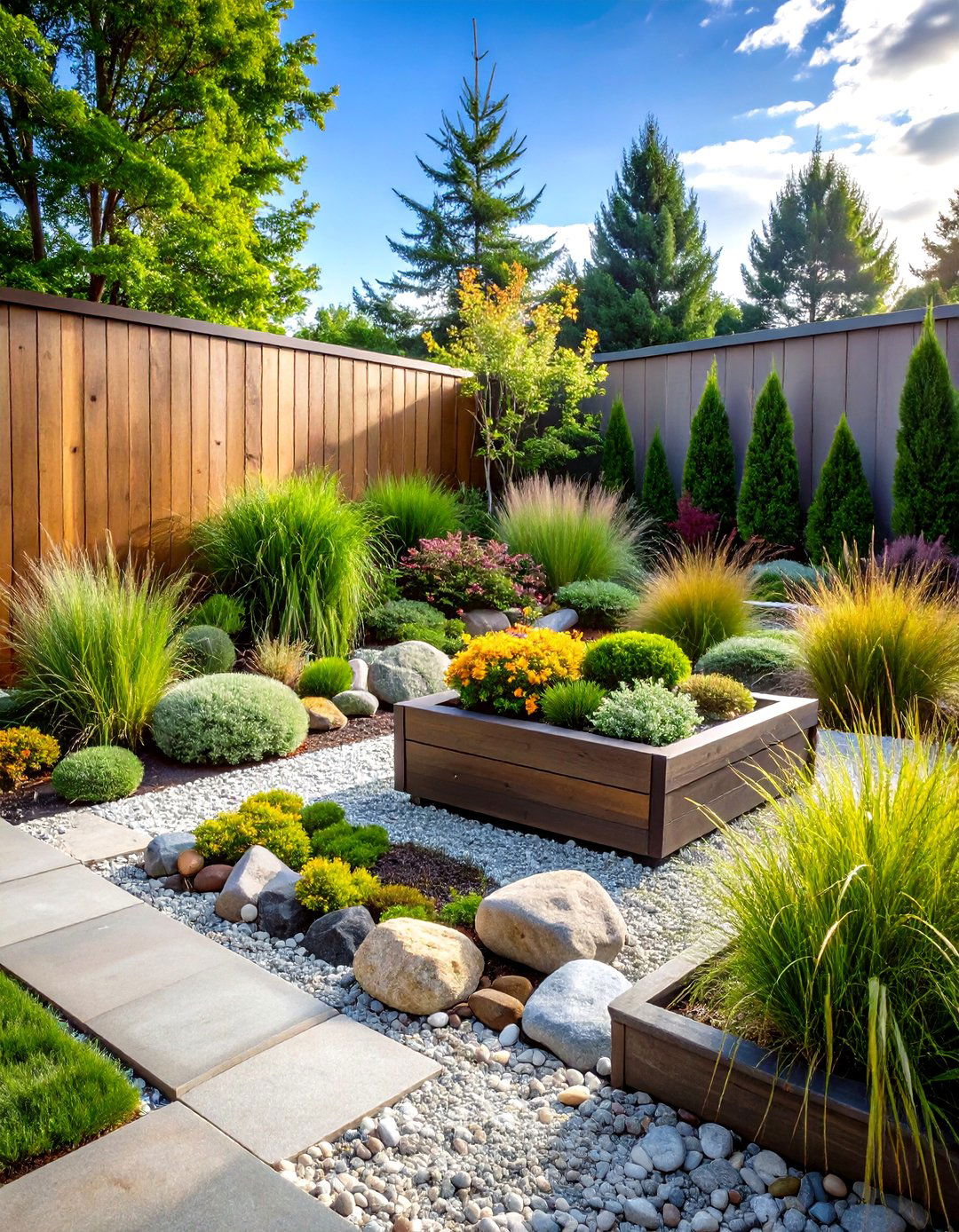
Create peaceful spaces using minimalist plant selections, natural materials, and harmonious design principles that promote relaxation and contemplation. This contemplative container garden approach emphasizes simplicity, balance, and natural beauty through careful selection of plants, stones, and container materials. Choose plants with calming qualities like ornamental grasses, mosses, small conifers, and flowering varieties with subtle colors and gentle fragrances. Incorporate natural elements like river rocks, driftwood, and sand to enhance meditative qualities while maintaining clean, uncluttered appearances. Position these container gardens in quiet areas where they can serve as focal points for reflection and stress relief. Consider adding small water features or wind chimes to enhance sensory experiences while avoiding overwhelming visual complexity that detracts from peaceful intentions.
11. Fragrant Aromatherapy Container Garden
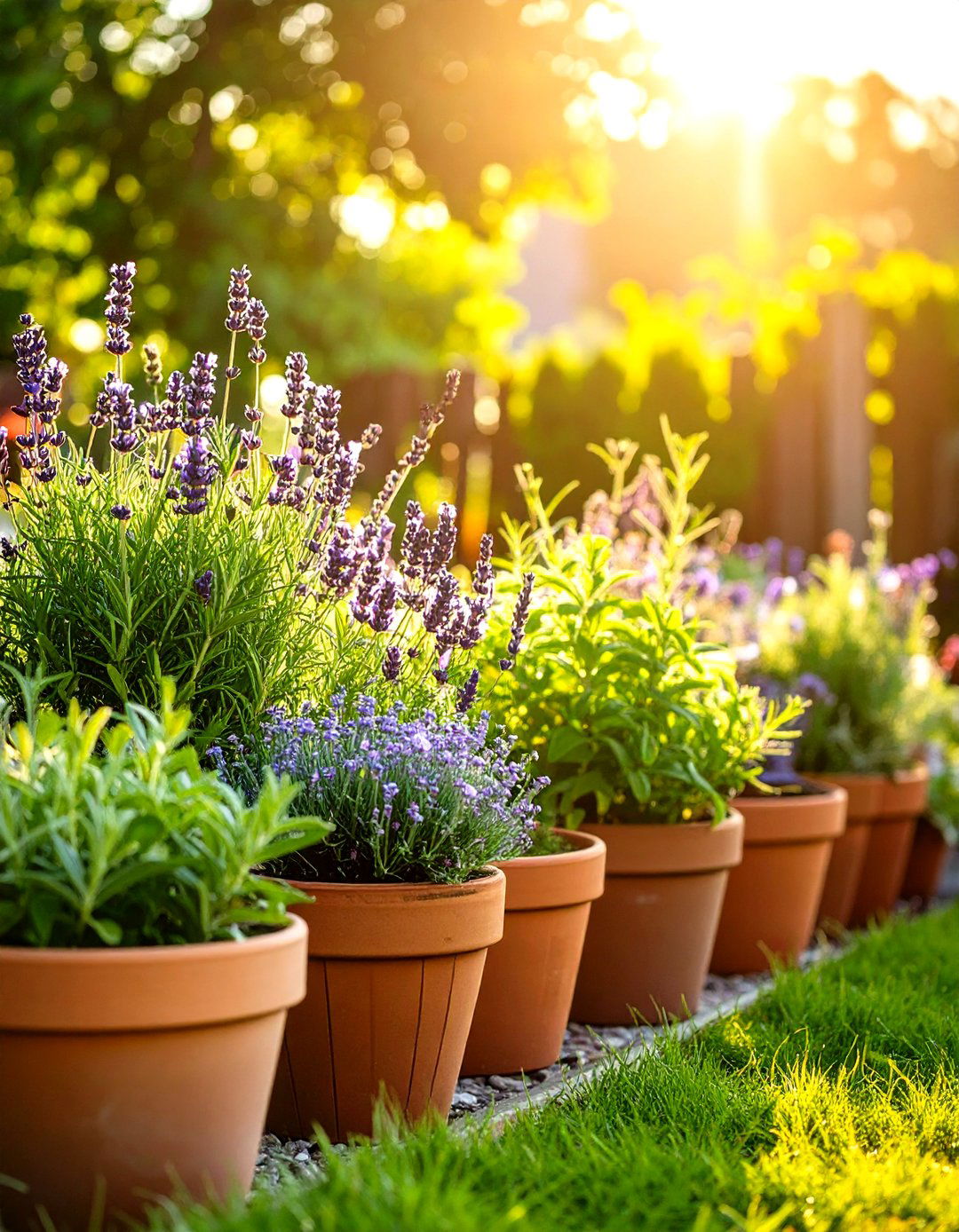
Develop sensory-rich displays featuring plants known for therapeutic scents like lavender, rosemary, mint, jasmine, and scented geraniums that provide natural stress relief. This wellness-focused container garden approach positions aromatic plants where gentle breezes or light touch releases beneficial essential oils. Group plants with complementary fragrances while considering bloom times to ensure season-long aromatic experiences. Many fragrant plants also offer culinary or medicinal uses, providing multiple benefits from single plantings. Position these container gardens near seating areas, pathways, or windows where fragrances can be easily enjoyed during daily activities. Research proper harvesting techniques for plants intended for teas, potpourri, or aromatherapy applications. Consider evening-fragrant varieties like night-blooming jasmine for different sensory experiences throughout daily cycles.
12. Drought-Tolerant Container Garden
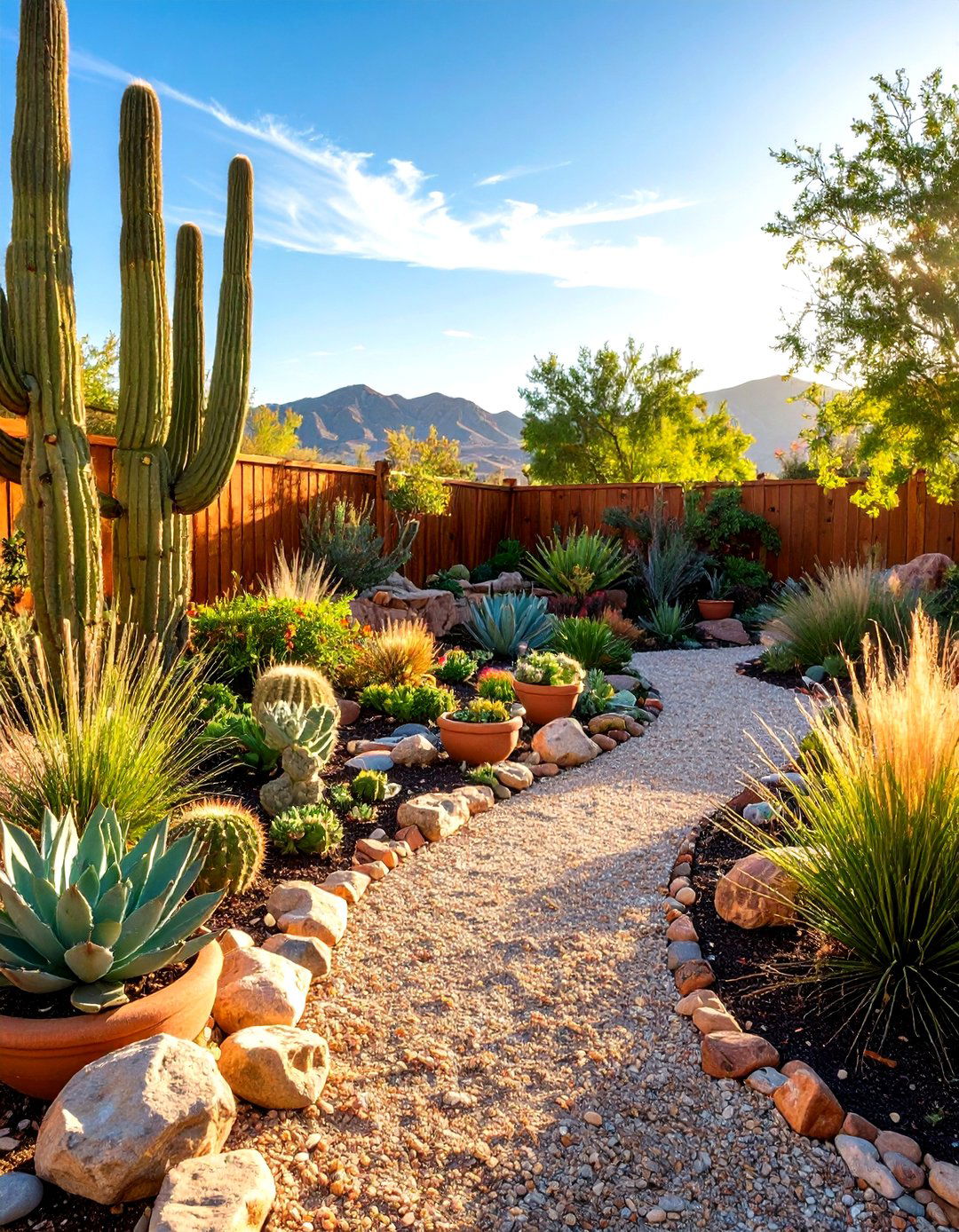
Develop water-wise displays using plants adapted to dry conditions, featuring succulents, ornamental grasses, Mediterranean herbs, and native drought-resistant varieties. This sustainable container garden approach reduces maintenance requirements while creating visually striking displays that thrive in challenging conditions. Select containers with excellent drainage and use specialized soil mixes designed for drought-tolerant plants, often incorporating sand or perlite for improved drainage. These container gardens excel in hot, sunny locations where other plants struggle, making them ideal for challenging microclimates. Group plants with similar water requirements while designing irrigation systems that provide deep, infrequent watering sessions. Consider decorative mulches like gravel or decorative stones that complement drought-tolerant plant aesthetics while reducing water evaporation. Many drought-tolerant plants offer stunning flowers and architectural forms that rival traditional garden favorites.
13. Shade-Loving Container Garden
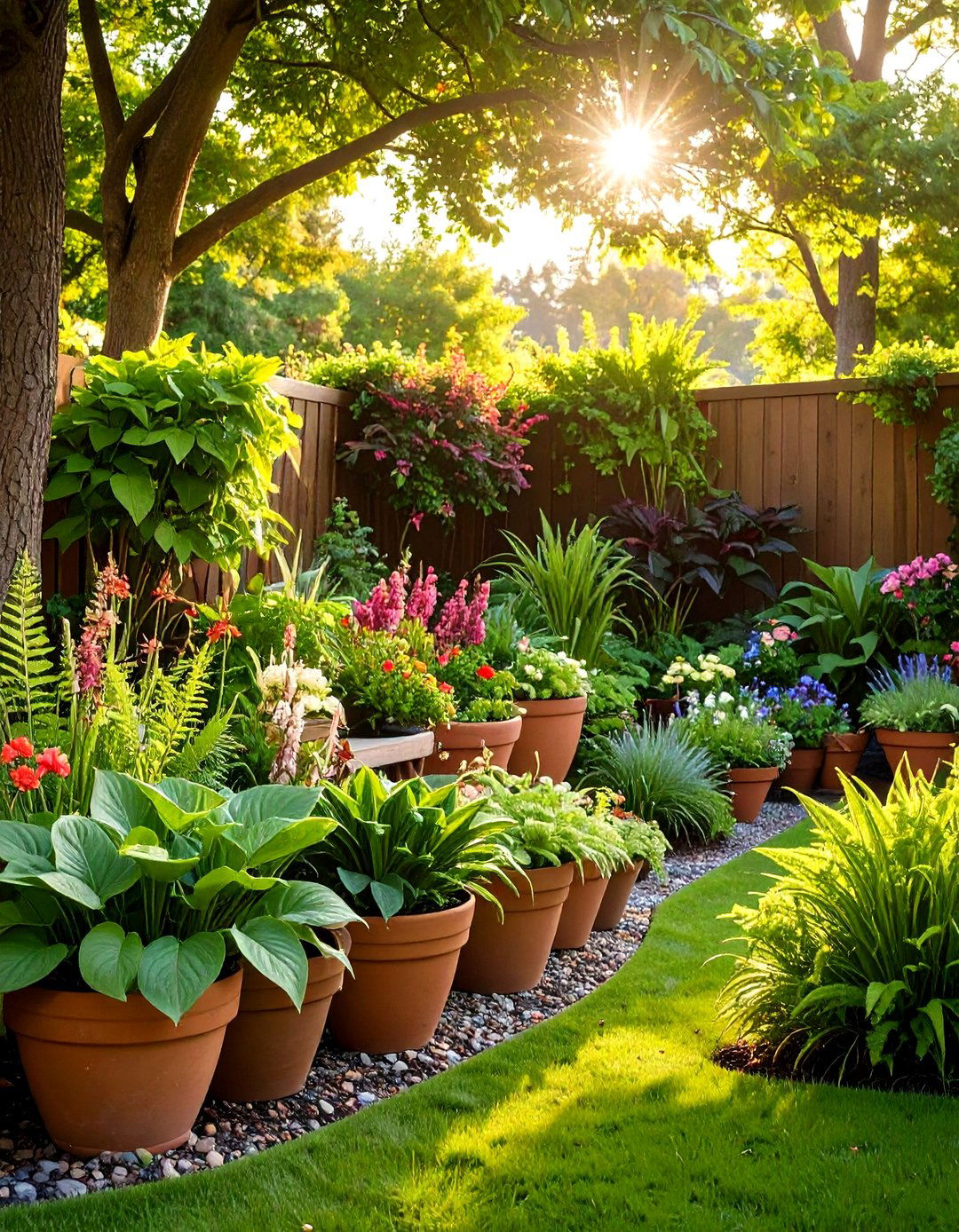
Transform darker areas into lush growing spaces using plants that thrive in low-light conditions, including ferns, hostas, caladiums, and flowering shade perennials. This specialized container garden approach brings life to areas often considered unsuitable for plant cultivation, such as north-facing patios or beneath tree canopies. Select containers in lighter colors that reflect available light while choosing plants known for their shade tolerance and attractive foliage. Many shade plants offer dramatic leaf patterns, textures, and colors that create sophisticated displays without relying on flower power. These container gardens often require less frequent watering due to reduced evaporation in shadier conditions. Consider seasonal interest through plants that offer different characteristics throughout growing seasons, such as spring-blooming bulbs followed by summer foliage displays and fall color changes.
14. Children's Discovery Container Garden
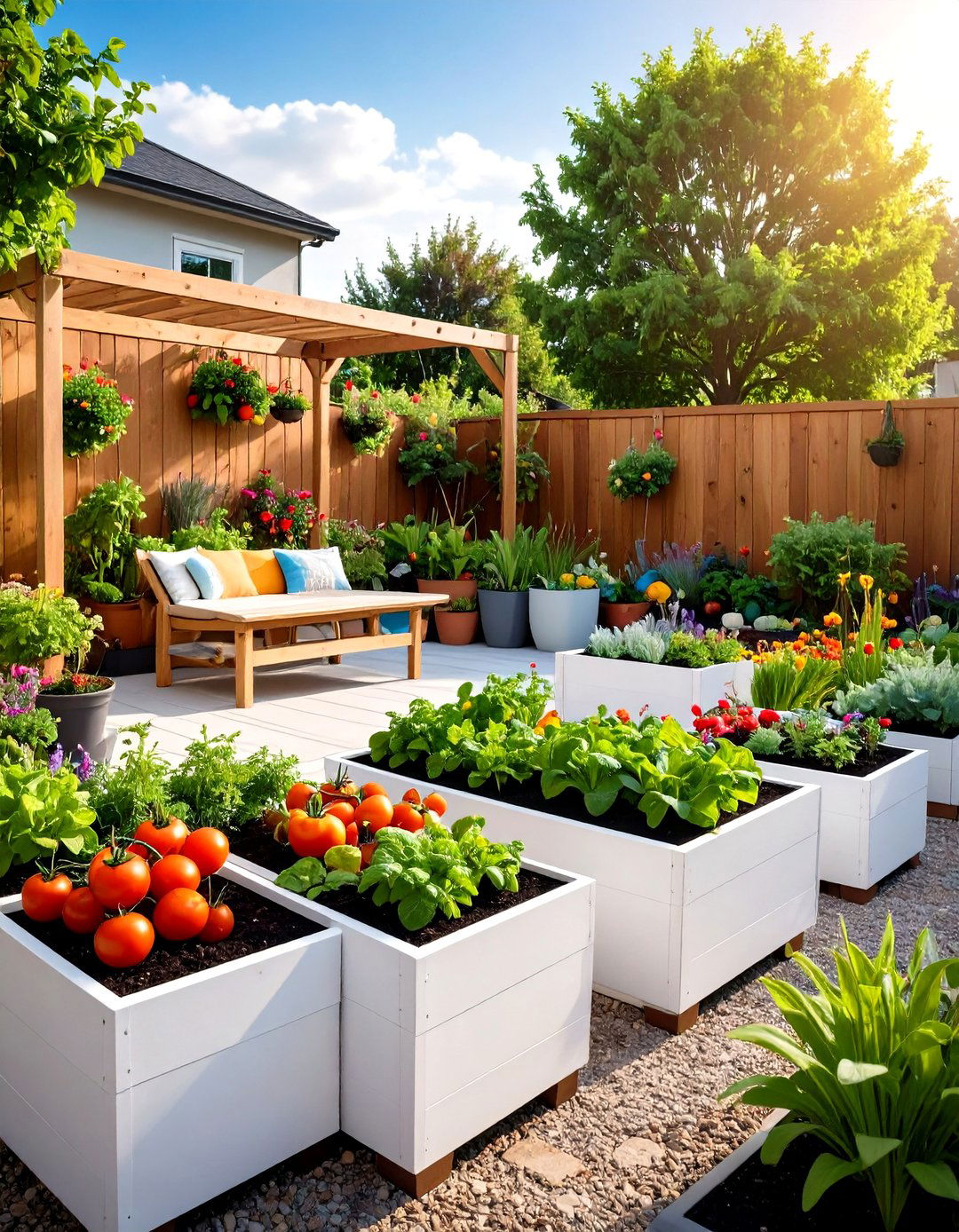
Design educational growing experiences using plants that engage young gardeners through interesting textures, unusual growth habits, and interactive features like touch-sensitive plants and vegetables. This educational container garden approach encourages learning through hands-on experiences while teaching responsibility and plant care basics. Choose fast-growing varieties that provide quick gratification, such as radishes, sunflowers, and cherry tomatoes that demonstrate clear growth progression. Include sensory plants like lamb's ear, mint, and fragrant flowers that invite exploration through touch and smell. Size containers appropriately for children's reach while providing sturdy, tip-resistant options that withstand enthusiastic young gardeners. Consider plants with educational value, such as those that change color, close when touched, or produce unusual fruits and vegetables that demonstrate plant diversity and adaptation.
15. Butterfly Pollinator Container Garden
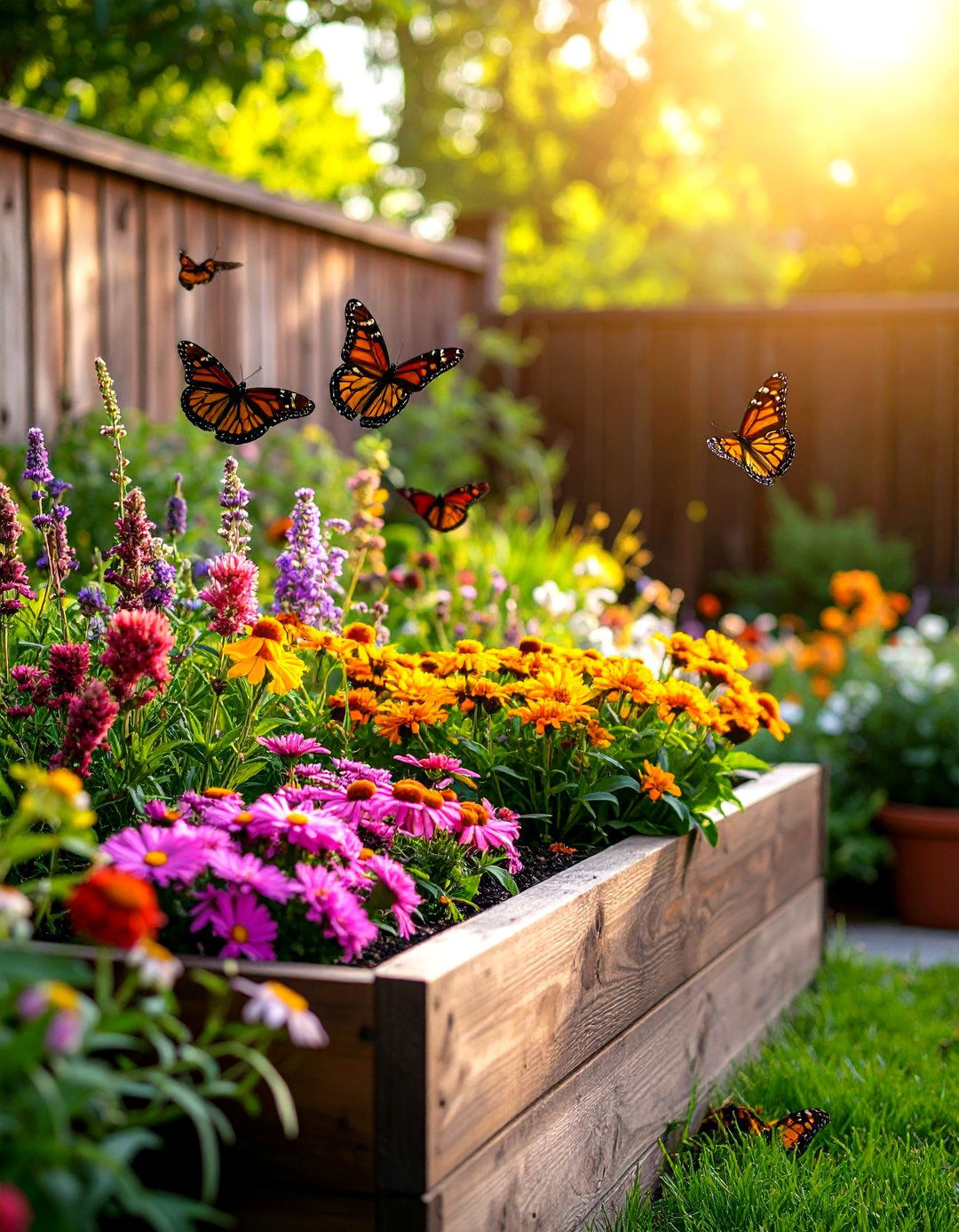
Create habitat-focused displays using plants specifically chosen to attract and support butterflies, bees, and other beneficial pollinators throughout their life cycles. This conservation-minded container garden approach combines environmental stewardship with beautiful displays that change seasonally as different pollinators visit. Select plants with various bloom times to provide continuous nectar sources, including early spring bulbs, summer perennials, and fall-blooming asters. Include host plants where butterflies lay eggs and caterpillars develop, such as milkweed for monarchs or parsley for swallowtails. Position these container gardens in sunny locations with wind protection where pollinators can easily access flowers. Avoid pesticide use that harms beneficial insects while providing shallow water sources for pollinator hydration. Consider native plant varieties that support regional pollinator populations and migration patterns.
16. Winter Interest Container Garden
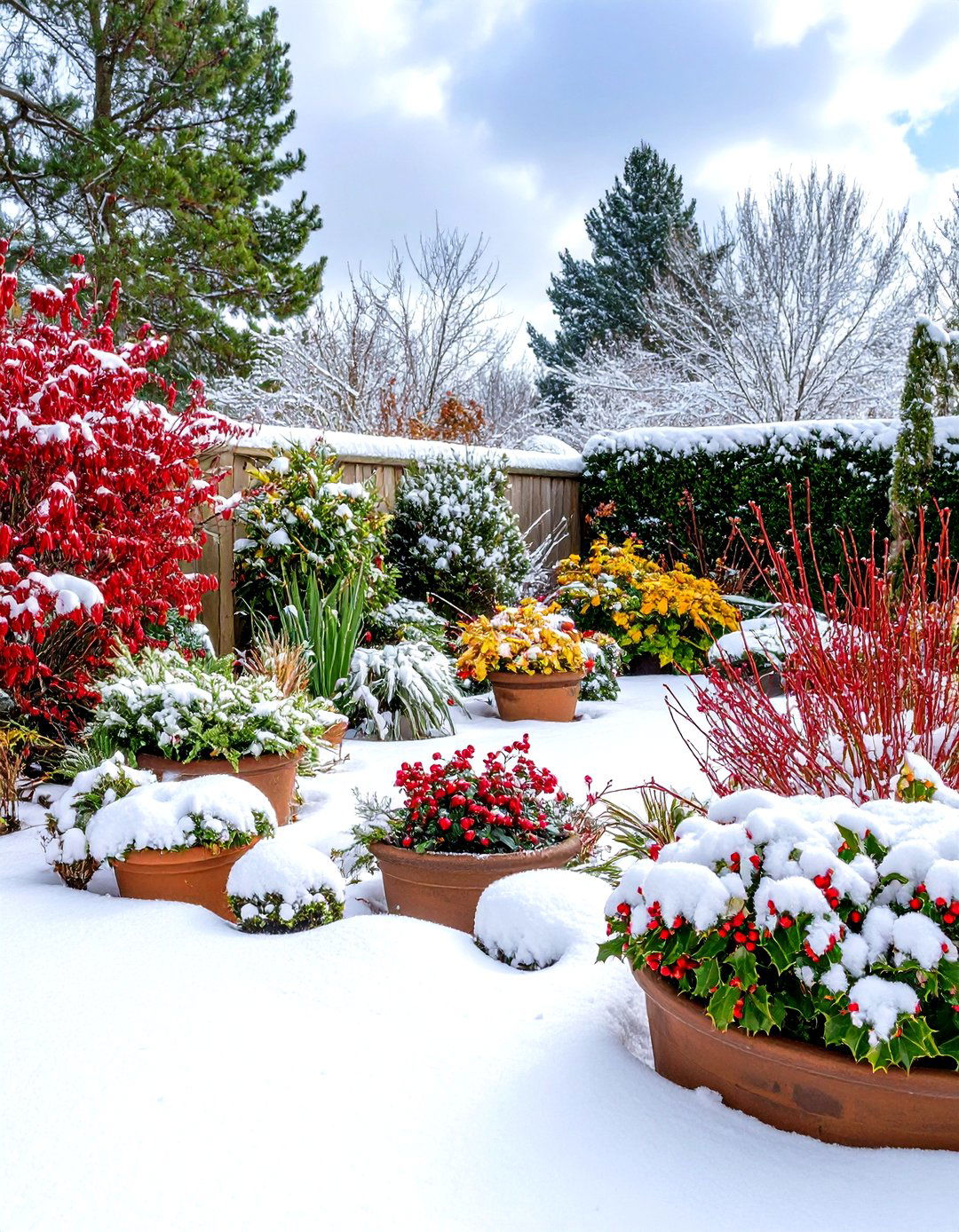
Design cold-season displays using evergreen plants, colorful stems, berry-producing shrubs, and architectural seed heads that provide visual appeal during dormant months. This season-extending container garden approach ensures year-round beauty in regions with distinct winter seasons. Choose plants with interesting bark, persistent berries, or colorful stems like red-twig dogwood and holly varieties that brighten winter landscapes. Include evergreen elements like dwarf conifers, ornamental grasses, and winter-blooming varieties such as hellebores where climate permits. These container gardens require winter protection in harsh climates, including insulation around containers and positioning in protected locations. Consider adding decorative elements like colorful branches, birch bark, or evergreen boughs to enhance winter displays while providing habitat for overwintering beneficial insects and winter birds.
17. Miniature Bonsai Container Garden
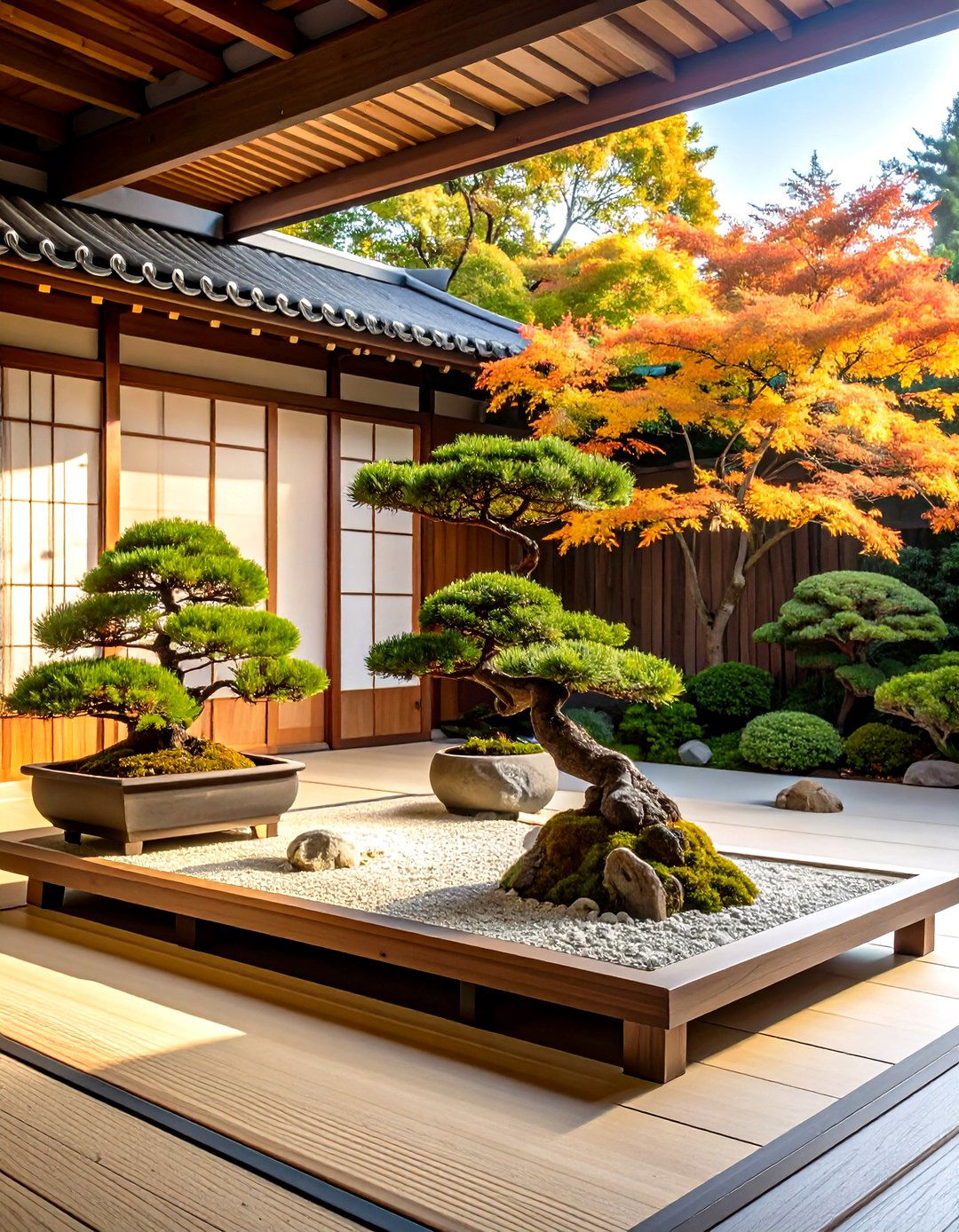
Cultivate living art using traditional bonsai techniques applied to small trees and shrubs maintained in shallow containers that emphasize natural beauty and artistic expression. This meditative container garden approach requires patience and regular attention while providing year-round interest through carefully shaped plant specimens. Choose appropriate species for bonsai cultivation, including traditional options like juniper, maple, and pine, or explore flowering varieties like azalea and cherry. Develop skills in pruning, wiring, and root management that maintain desired proportions while ensuring plant health. These container gardens serve as focal points that invite close inspection and contemplation. Position displays where they receive appropriate light while protecting valuable specimens from extreme weather conditions. Consider joining bonsai societies for expert guidance and access to specialized tools and materials required for proper bonsai maintenance and development.
18. Cottage Style Container Garden
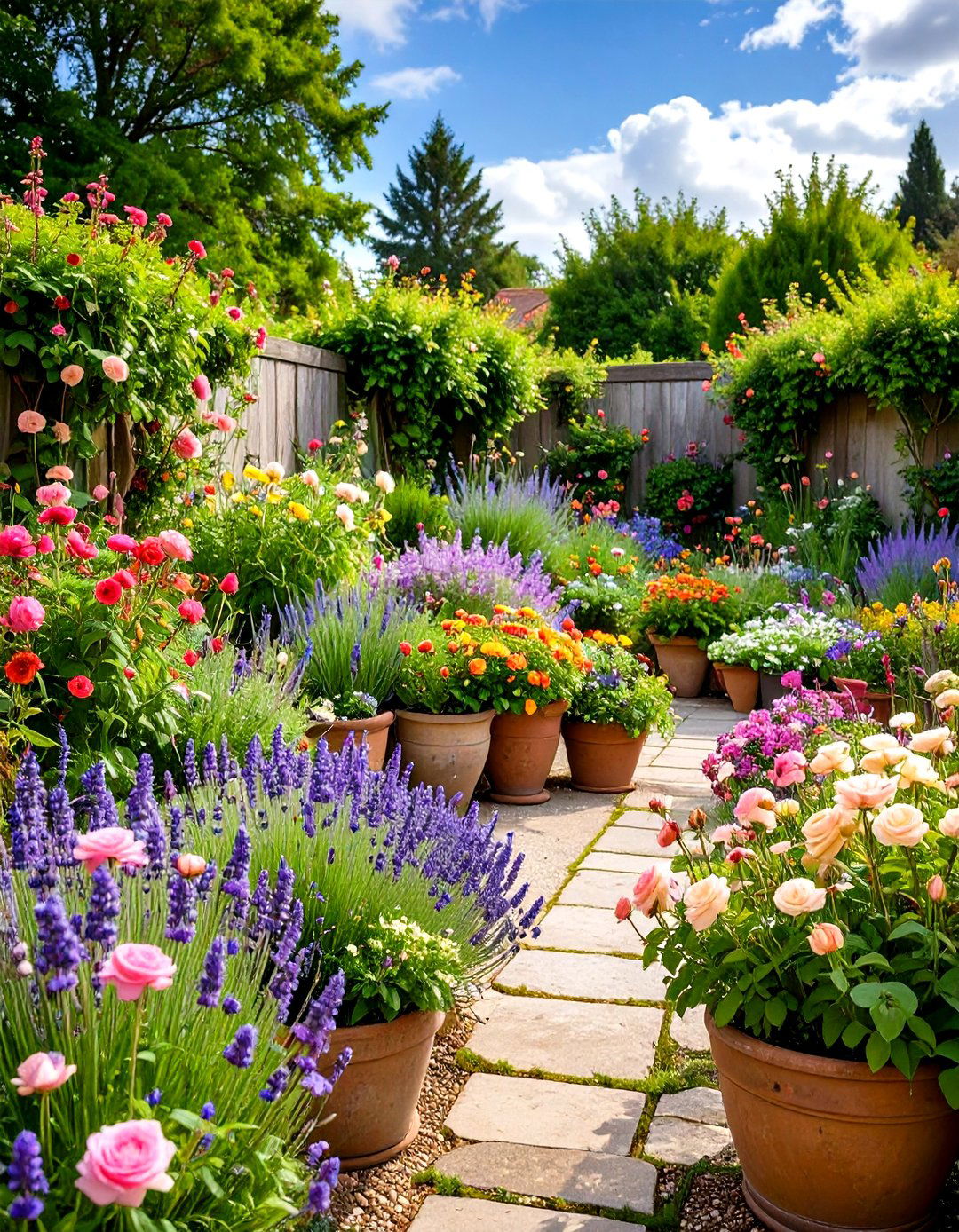
Create romantic, informal displays using traditional cottage garden plants like roses, lavender, sweet peas, and mixed flowering annuals arranged in weathered or vintage-style containers. This nostalgic container garden approach emphasizes abundance, fragrance, and informal beauty reminiscent of English countryside gardens. Choose plants with cottage garden heritage, including climbing roses, cottage pinks, hollyhocks, and herb varieties that provide both beauty and function. Arrange containers in casual groupings that appear naturally evolved rather than formally planned, using varying heights and container styles. These container gardens often incorporate edible flowers, herbs, and vegetables mixed with ornamental varieties. Select containers with patina or weathered appearances that complement the informal cottage aesthetic, such as aged terra cotta, wooden boxes, or repurposed vintage items that add character and story to displays.
19. Modern Architectural Container Garden
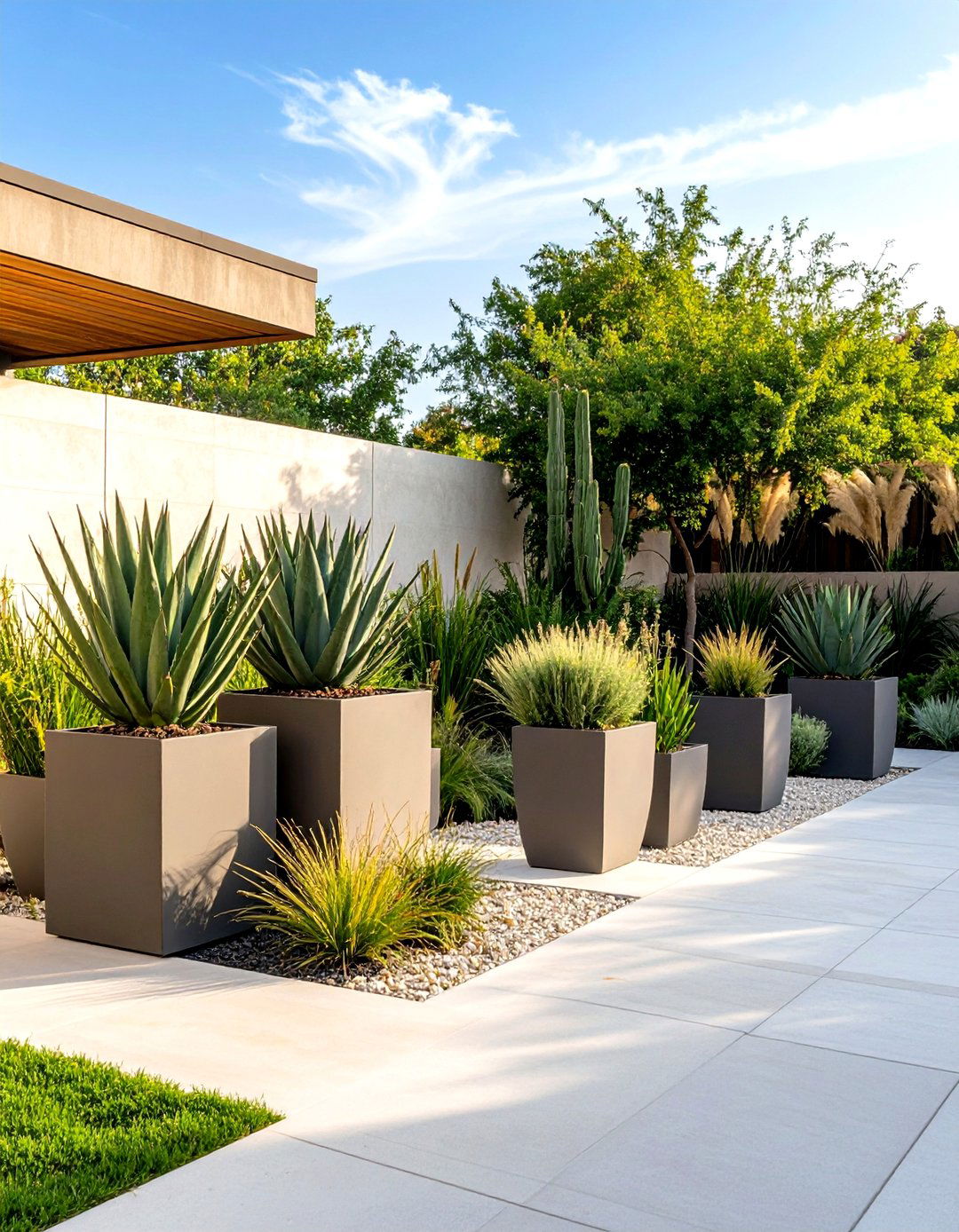
Design sophisticated displays using contemporary containers and structural plants that complement modern architecture and minimalist landscape design principles. This contemporary container garden approach emphasizes clean lines, geometric forms, and dramatic plant specimens that serve as living sculptures. Choose plants with architectural qualities like agaves, ornamental grasses, and specimen trees with interesting branching patterns or foliage forms. Select containers in contemporary materials like fiberglass, metal, or concrete with geometric shapes and neutral colors that integrate with modern design aesthetics. These container gardens often feature single-specimen displays that highlight individual plant characteristics rather than mixed plantings. Position containers to create visual rhythm and balance while considering sightlines from interior spaces and integration with architectural elements like patios, walkways, and building facades.
20. Indoor Windowsill Container Garden
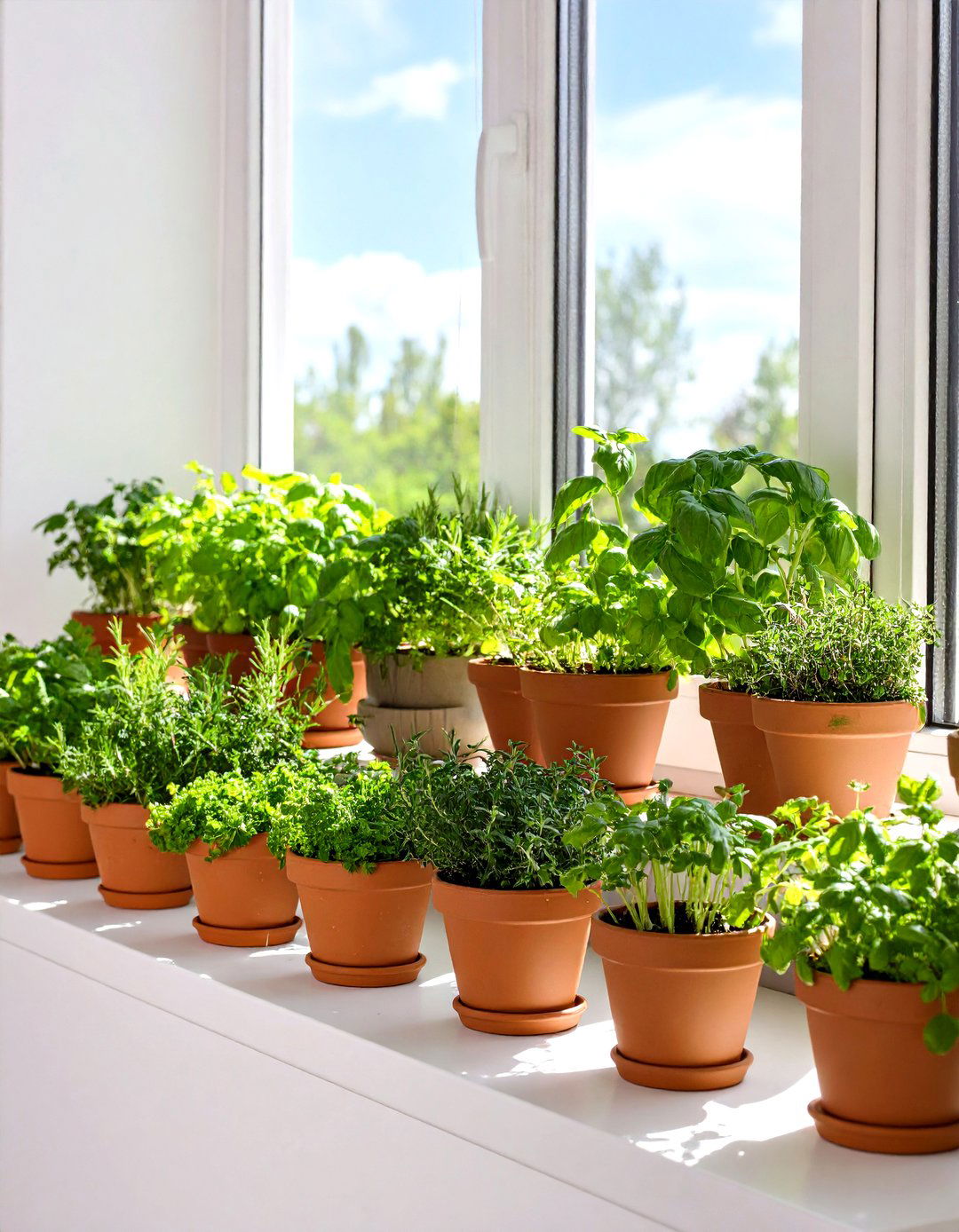
Maximize interior growing potential using sunny windows and compact containers designed for houseplant cultivation, featuring herbs, leafy greens, and flowering plants. This year-round container garden approach brings growing opportunities indoors while providing fresh ingredients and natural beauty throughout seasons. Choose containers with drainage systems appropriate for indoor use, including saucers or self-watering options that protect furniture and flooring. Select plants suited to available light conditions while considering rotation schedules that ensure adequate illumination for all specimens. These container gardens require attention to humidity, air circulation, and temperature consistency for optimal plant health. Consider supplemental lighting during shorter winter days while providing adequate space for plant growth and air circulation around containers.
Conclusion:
Container gardening opens unlimited possibilities for creating beautiful, productive growing spaces regardless of location constraints or experience levels. These 20 container garden ideas demonstrate how creative planning, appropriate plant selection, and thoughtful design can transform any space into a thriving garden sanctuary. From practical herb gardens to artistic displays, each approach offers unique benefits while accommodating different lifestyles, climates, and aesthetic preferences. Success depends on matching plant requirements with container conditions while maintaining consistent care and attention to seasonal needs.


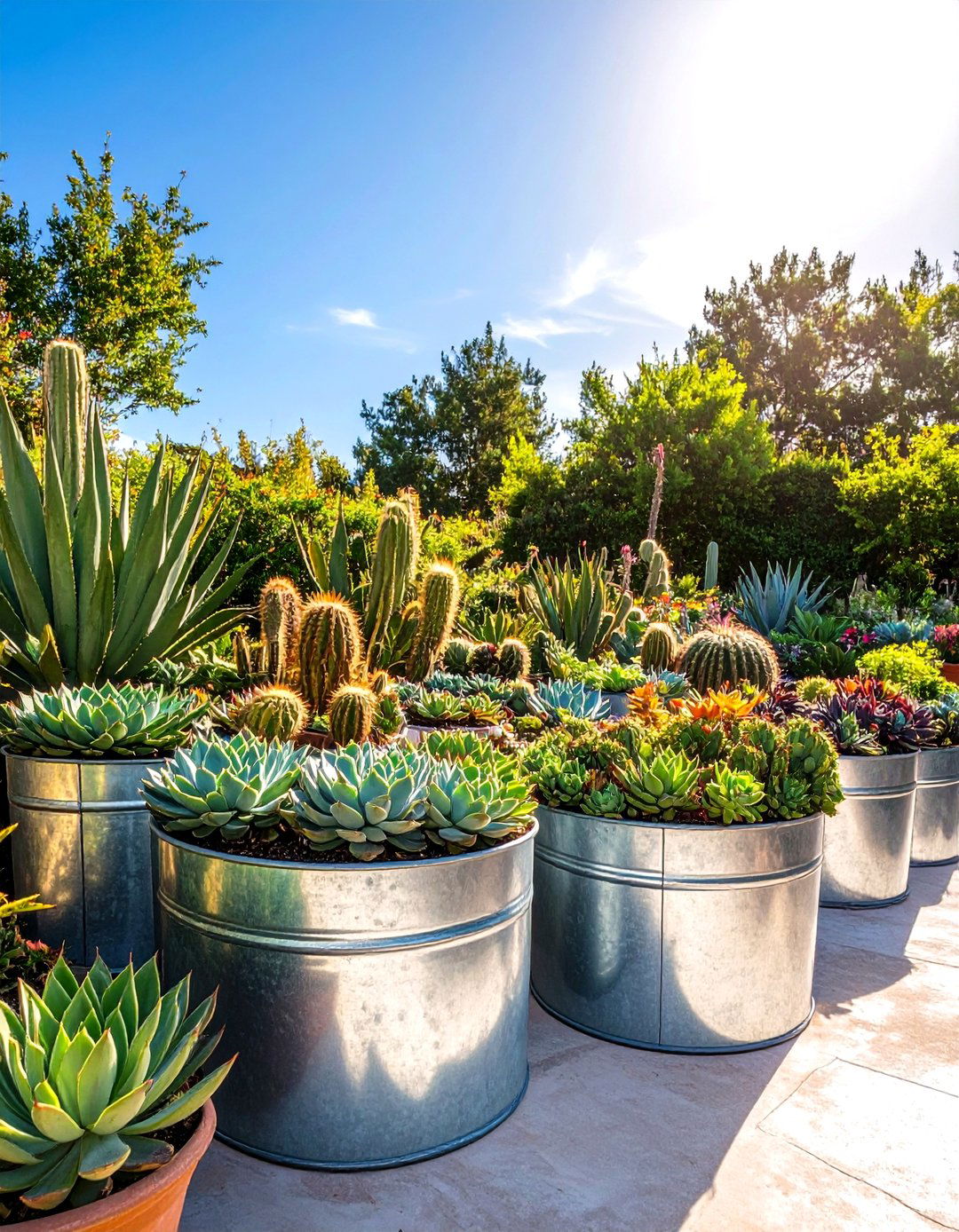

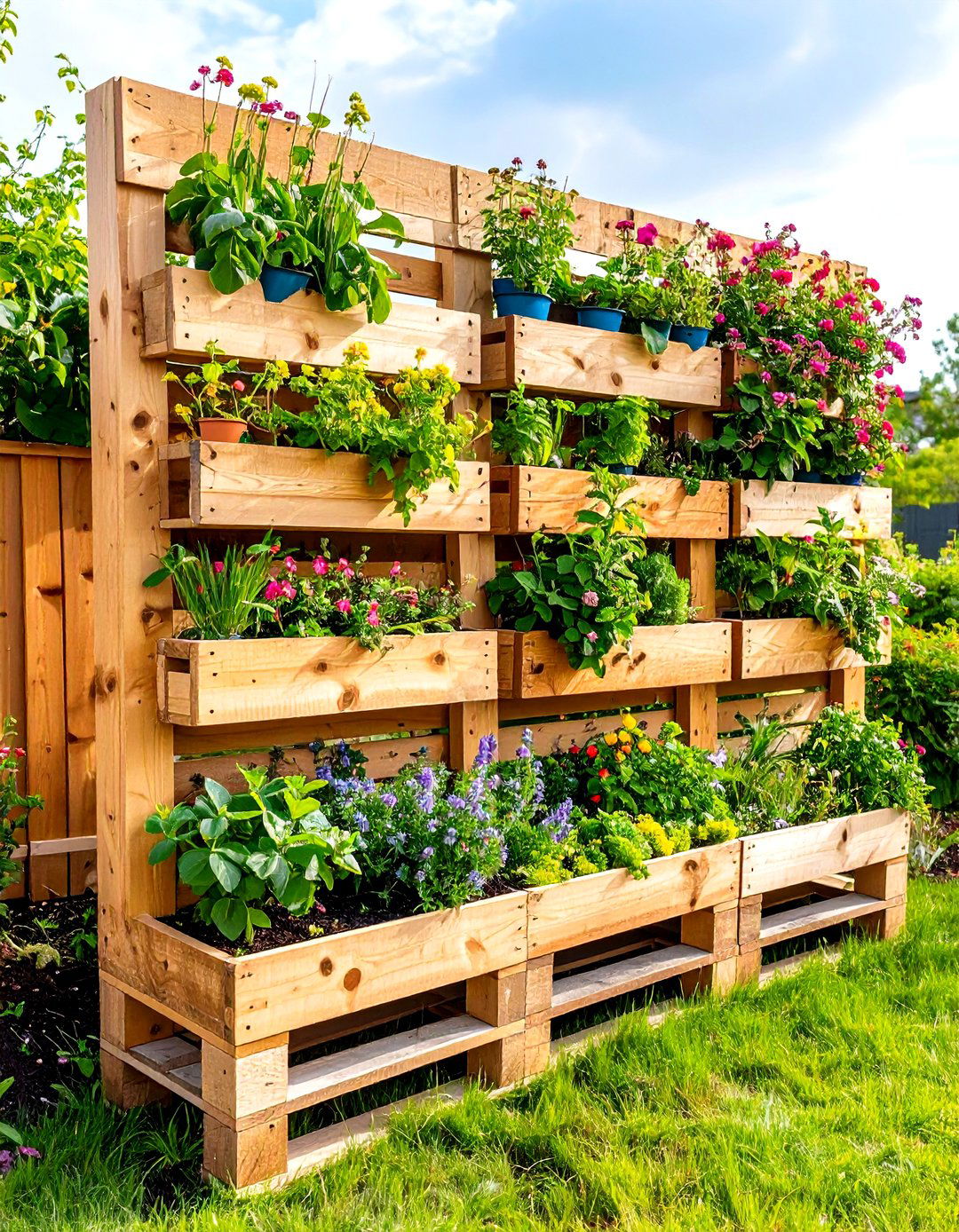
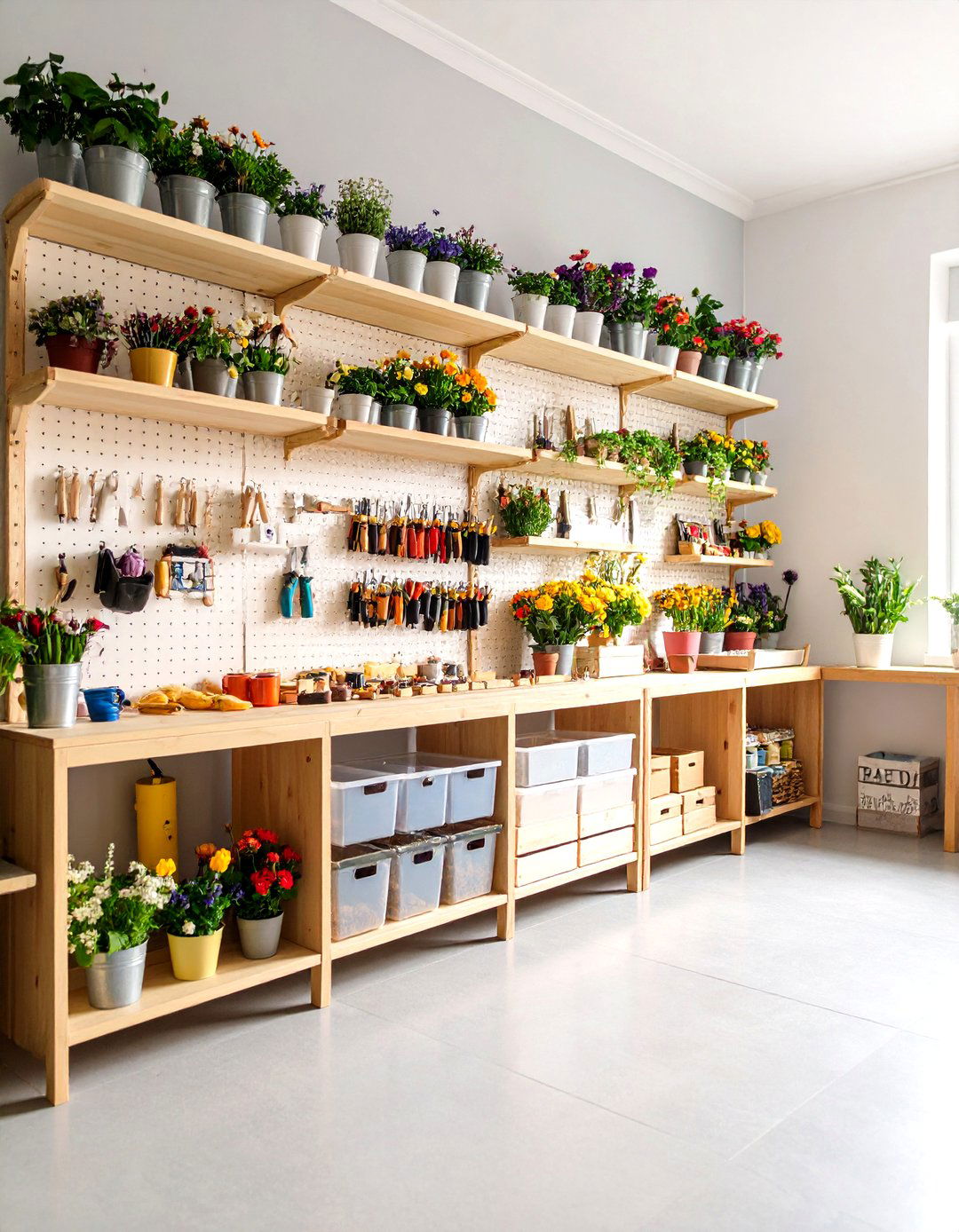
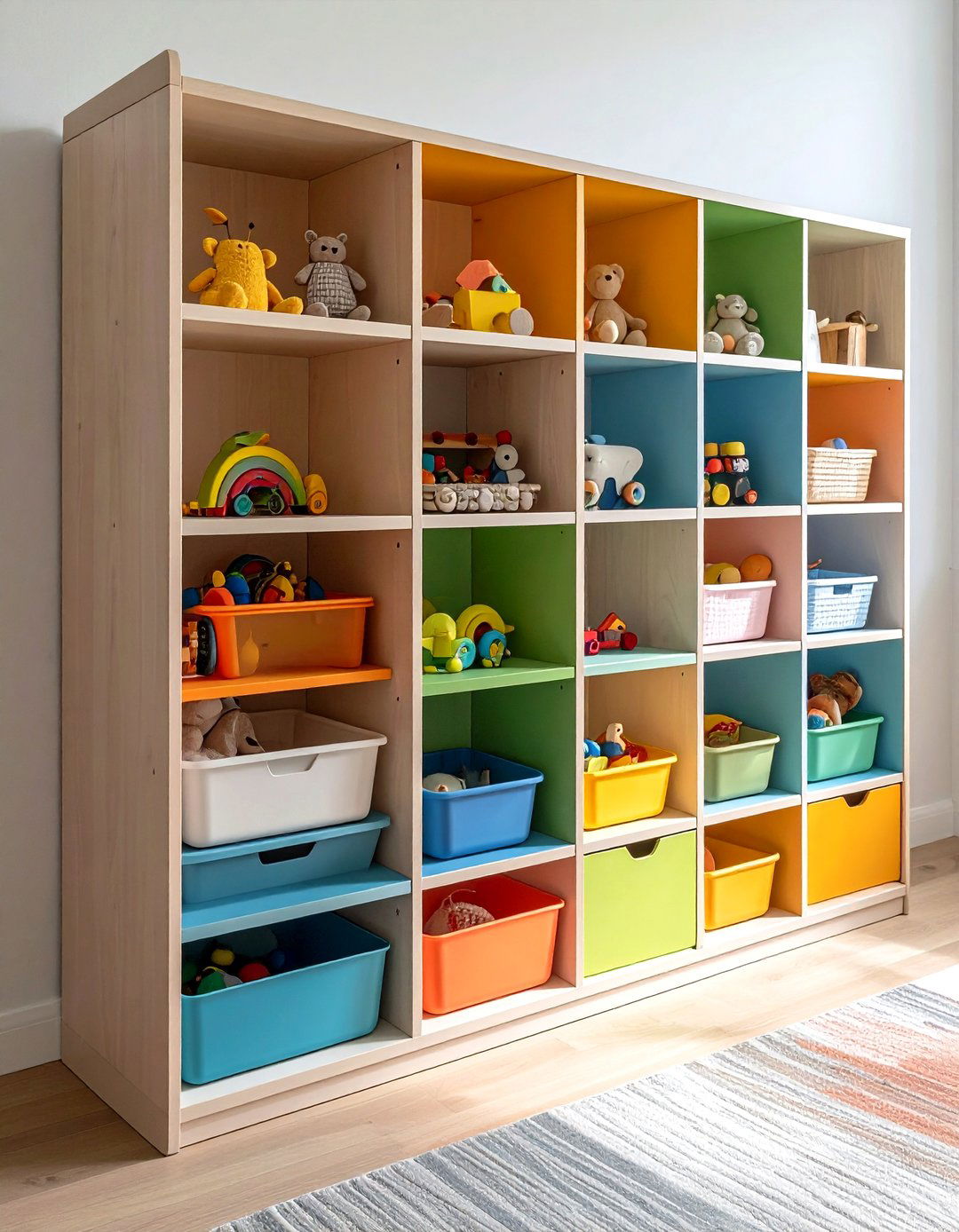
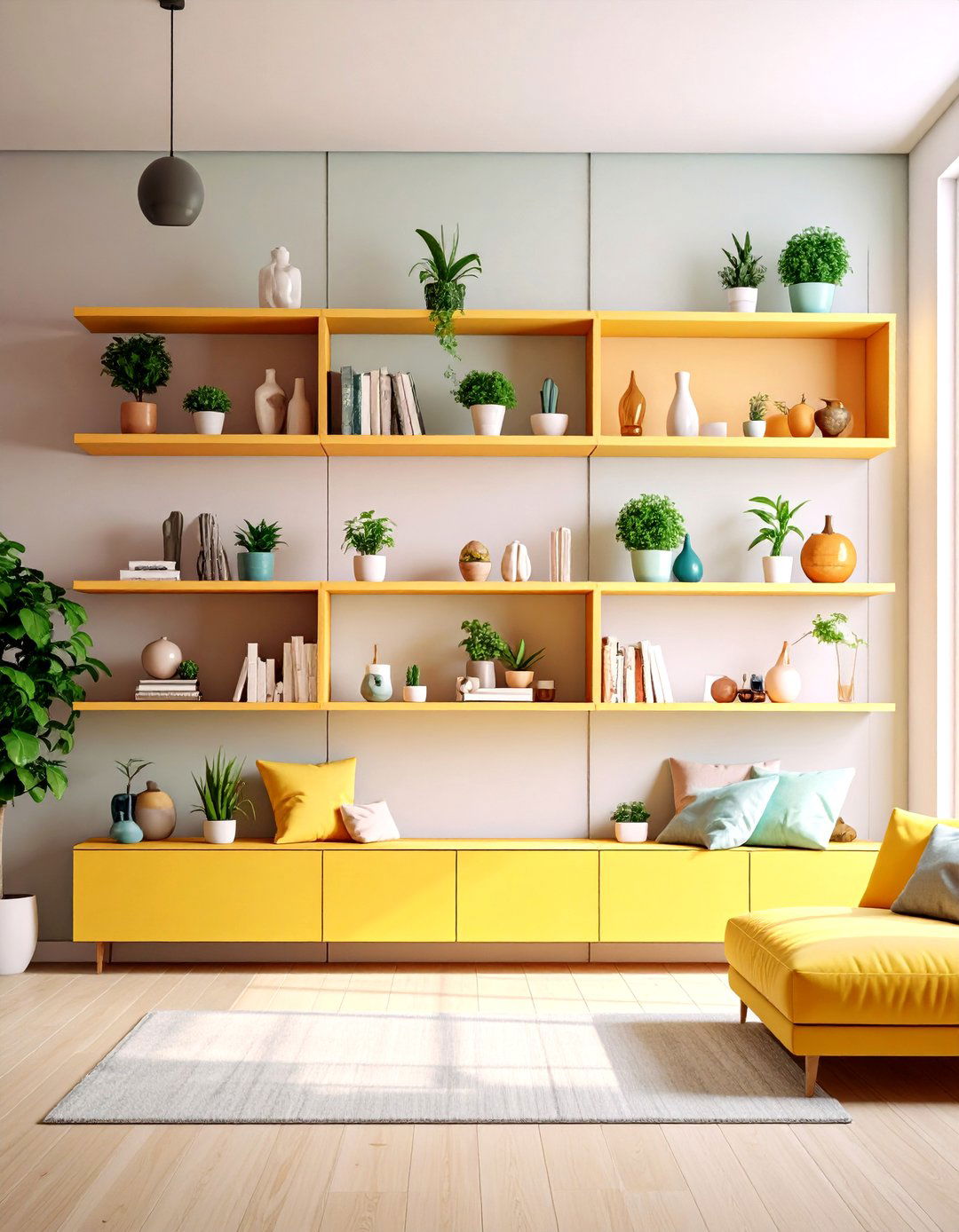
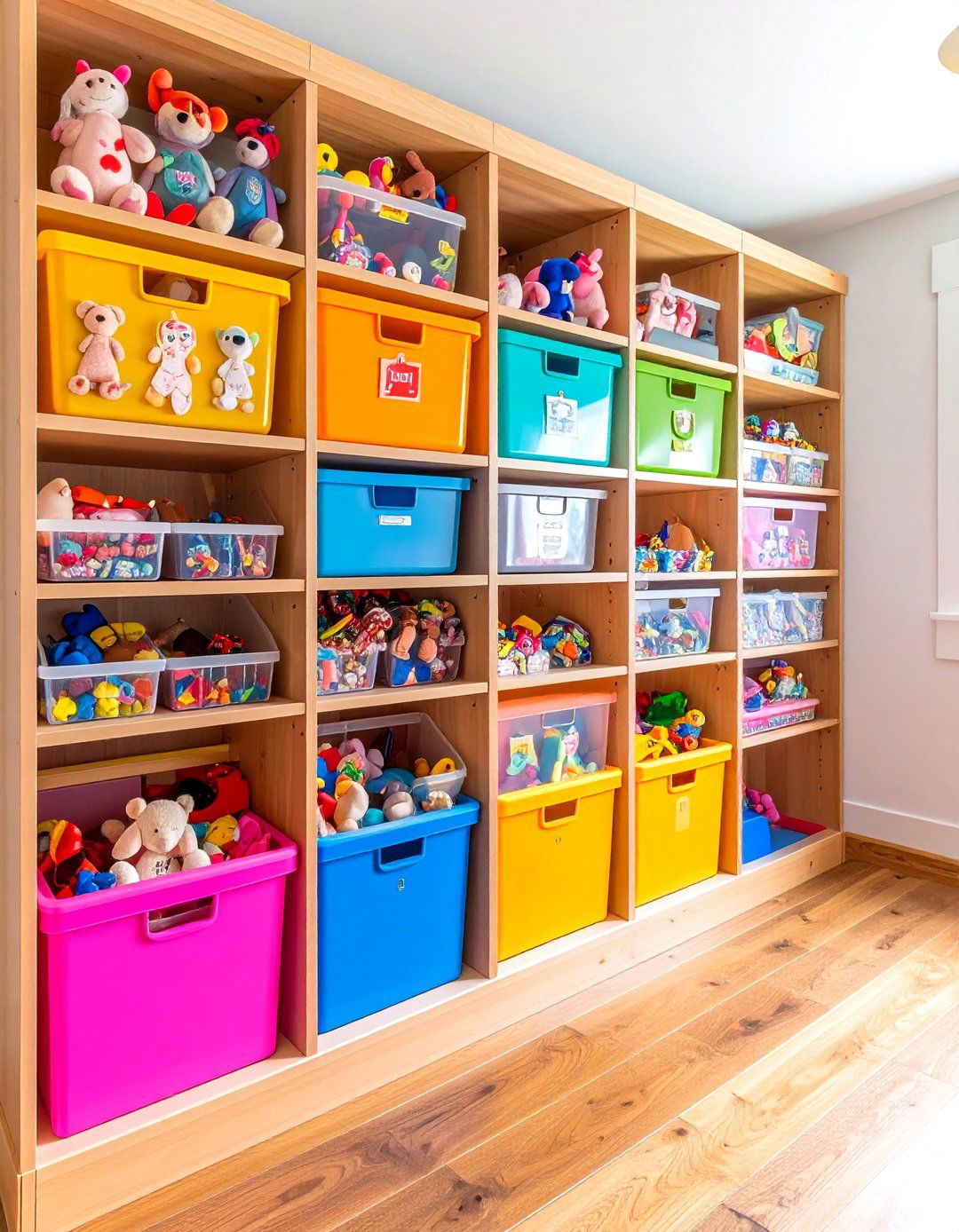

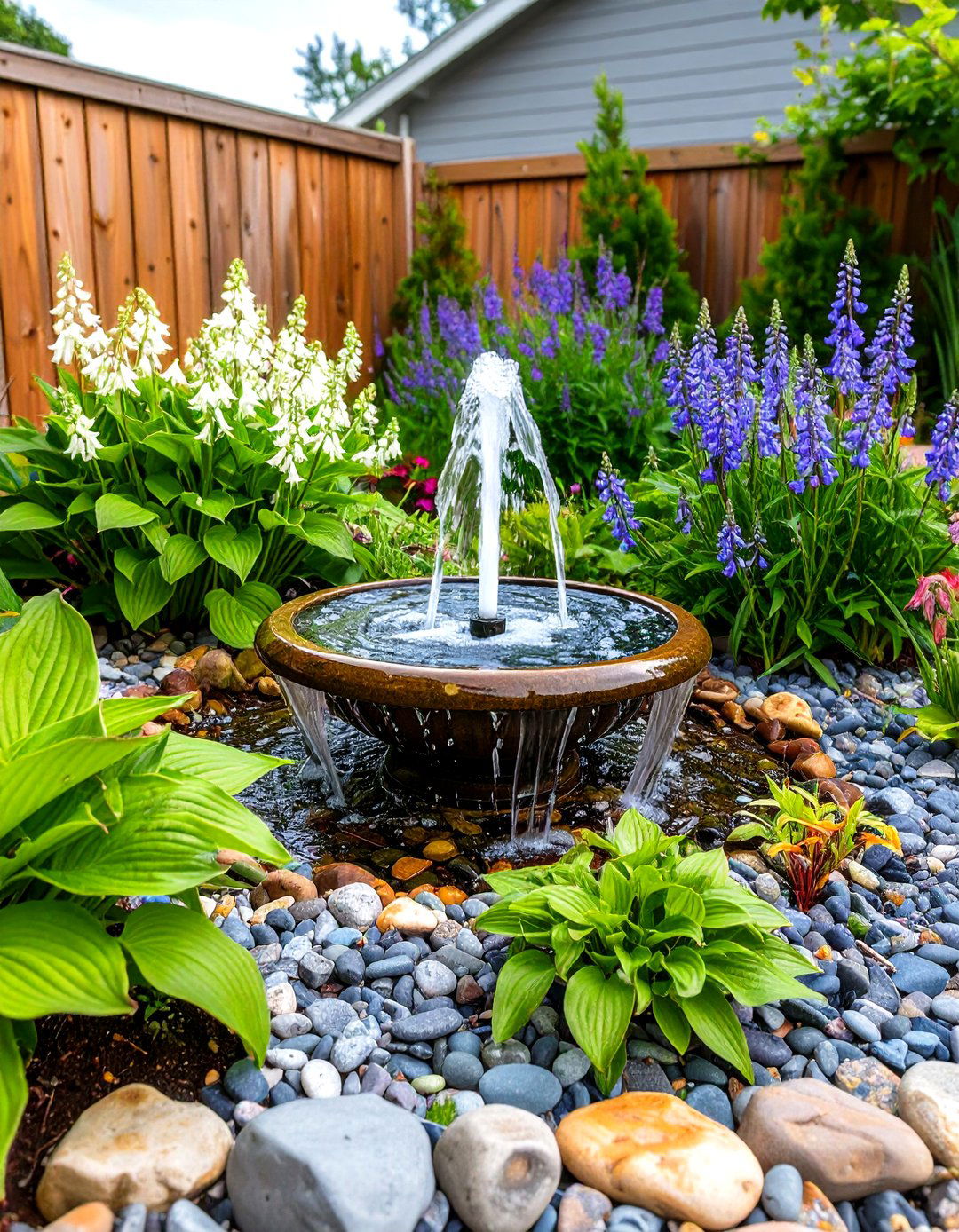
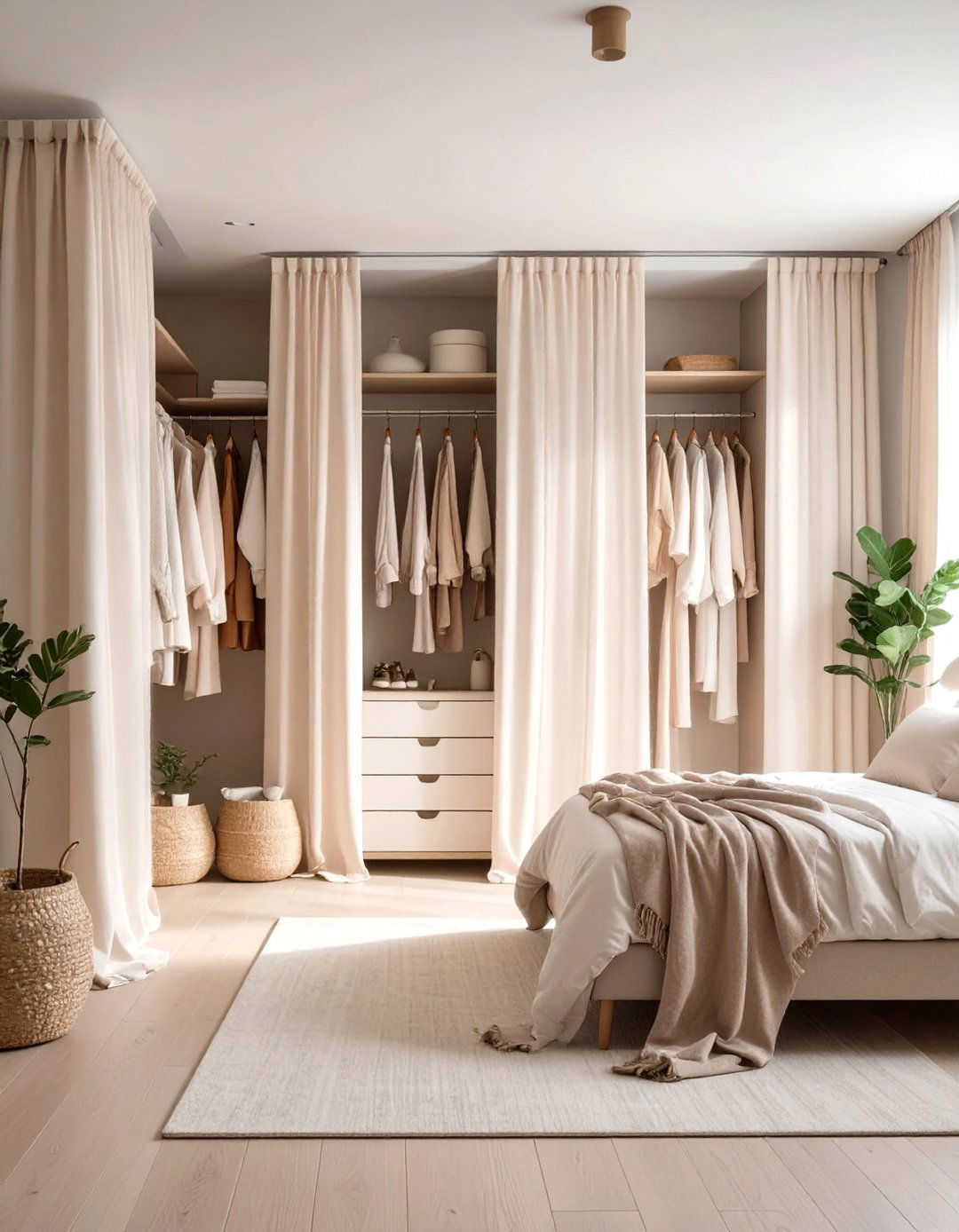
Leave a Reply